
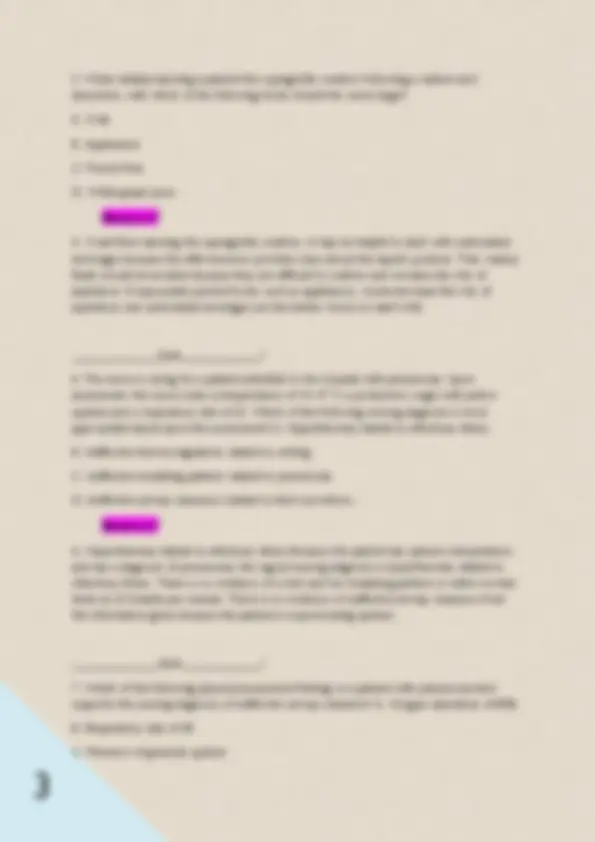
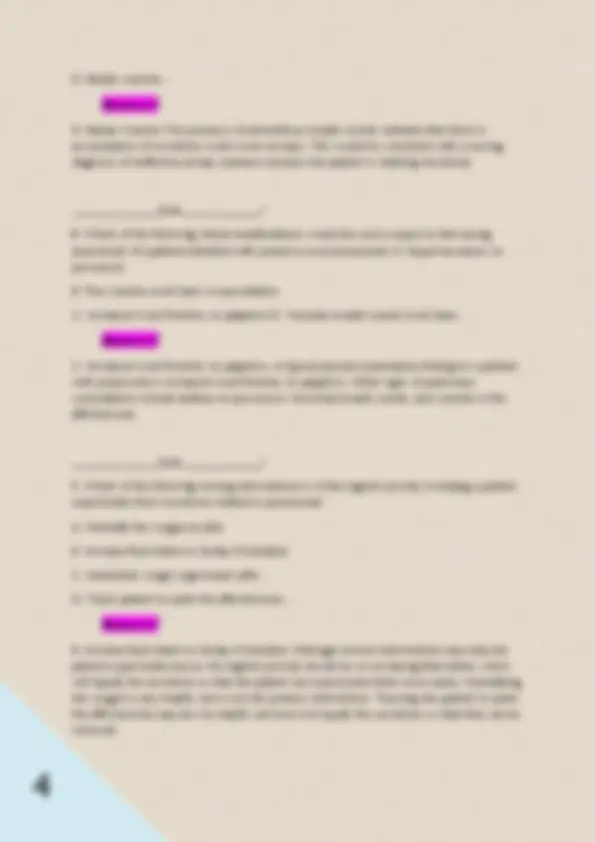
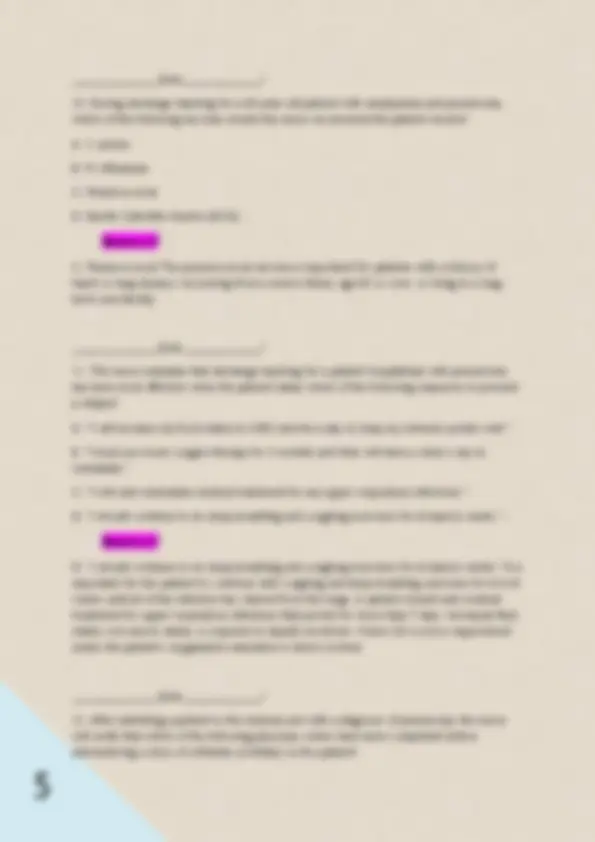
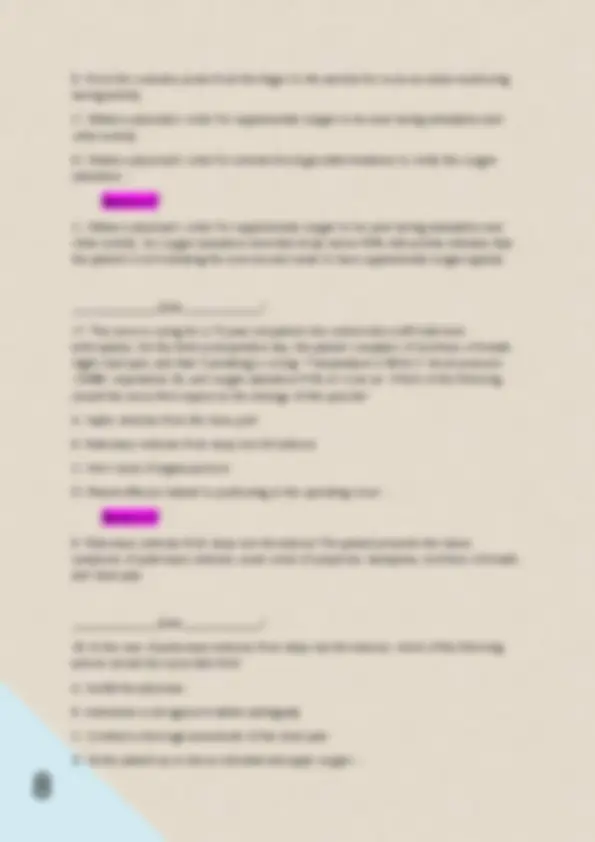
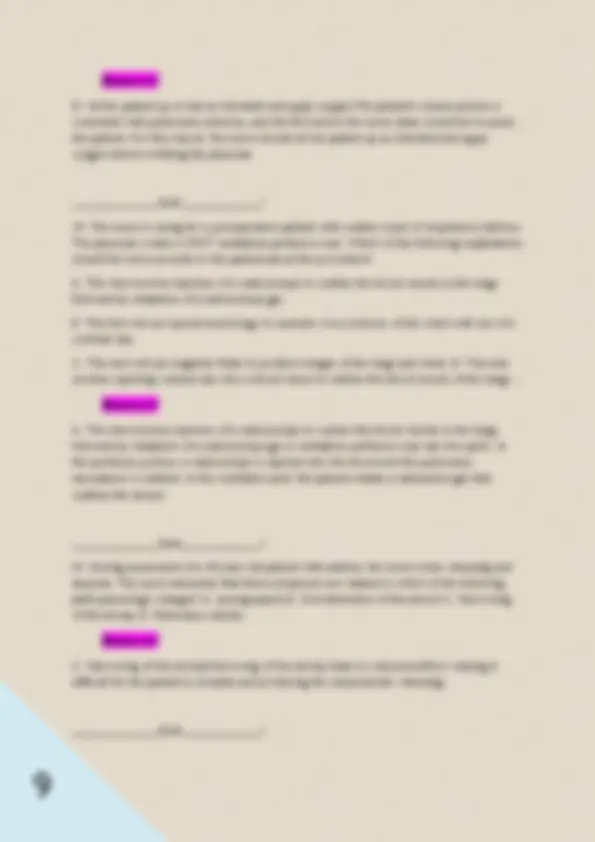
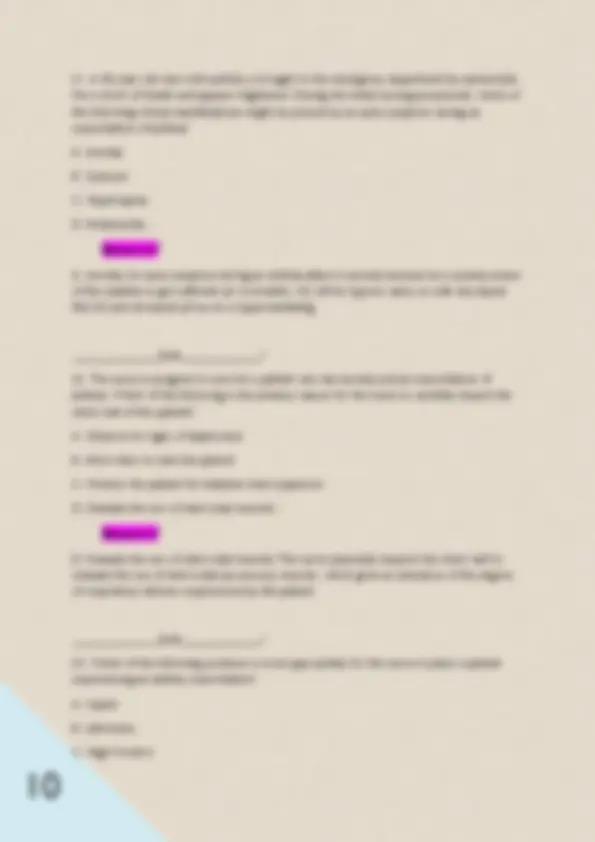
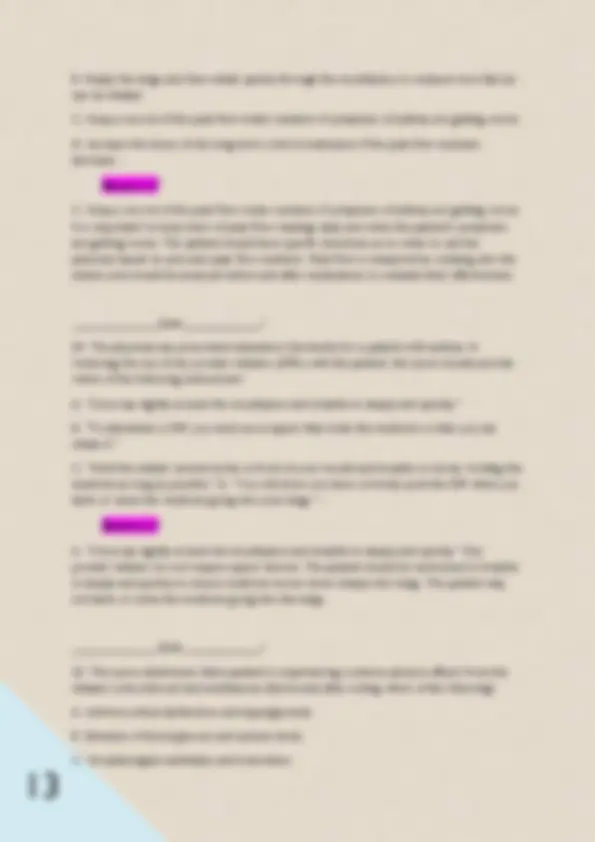
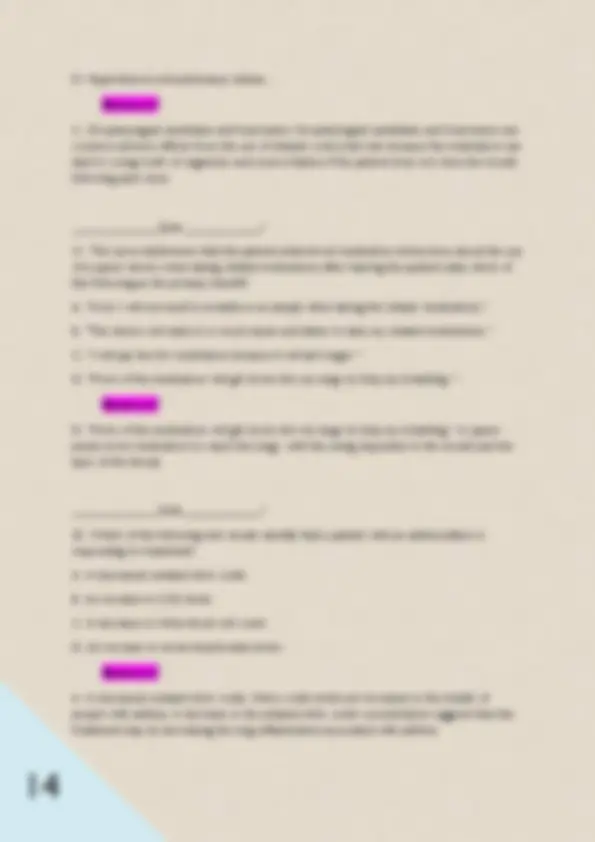
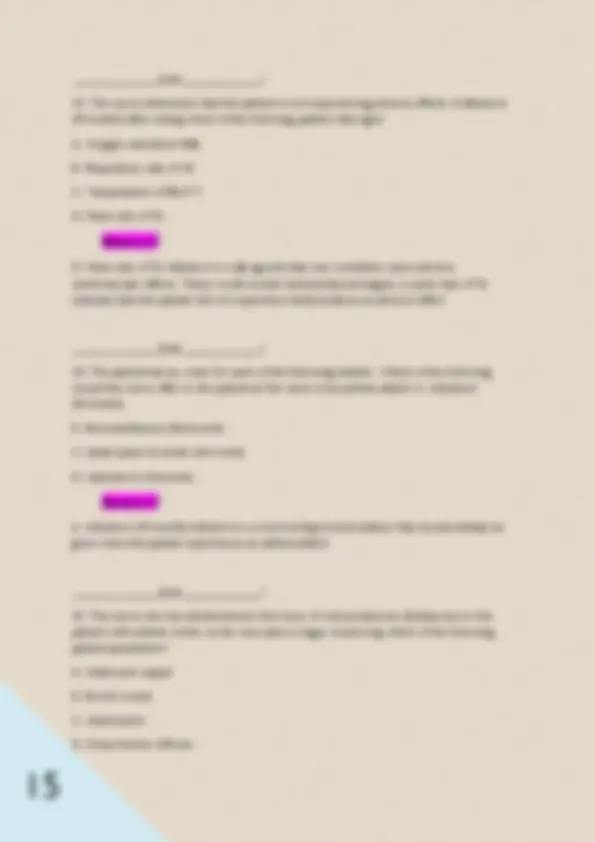
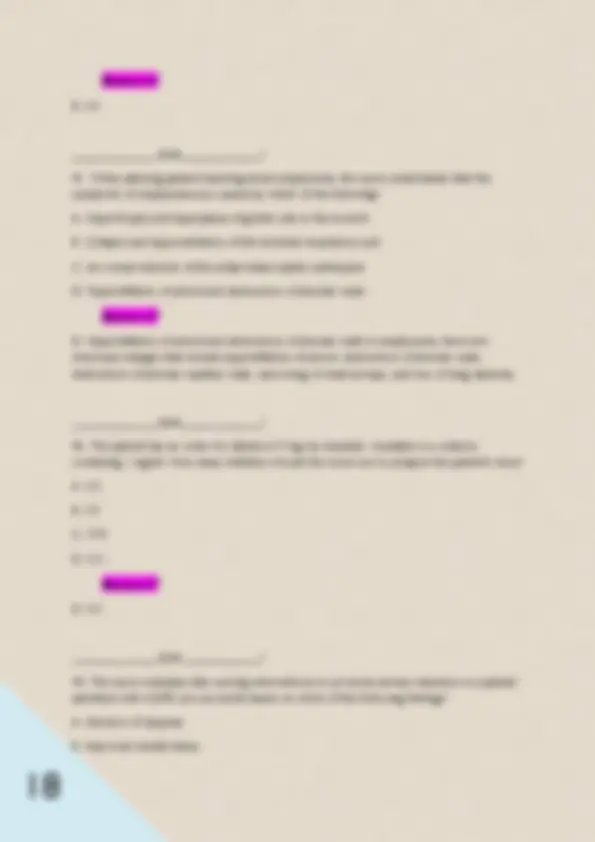
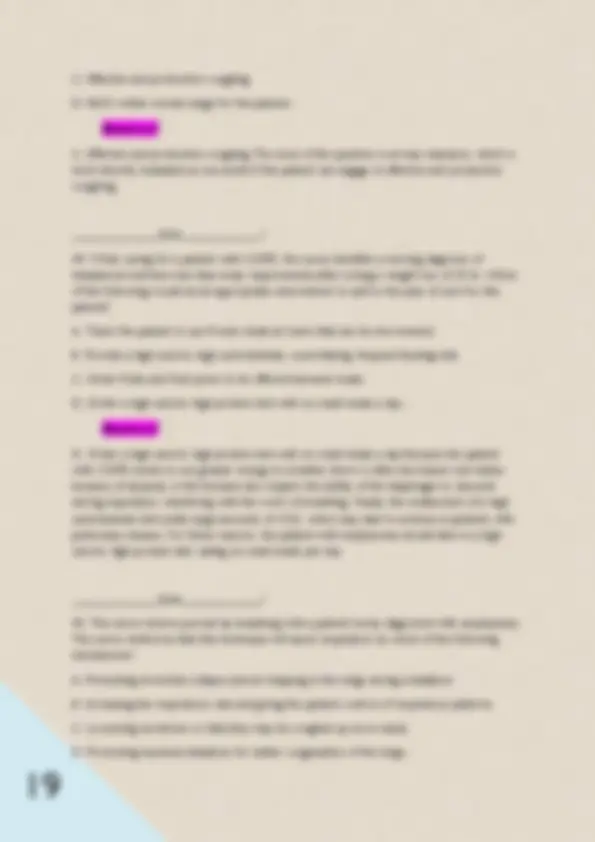
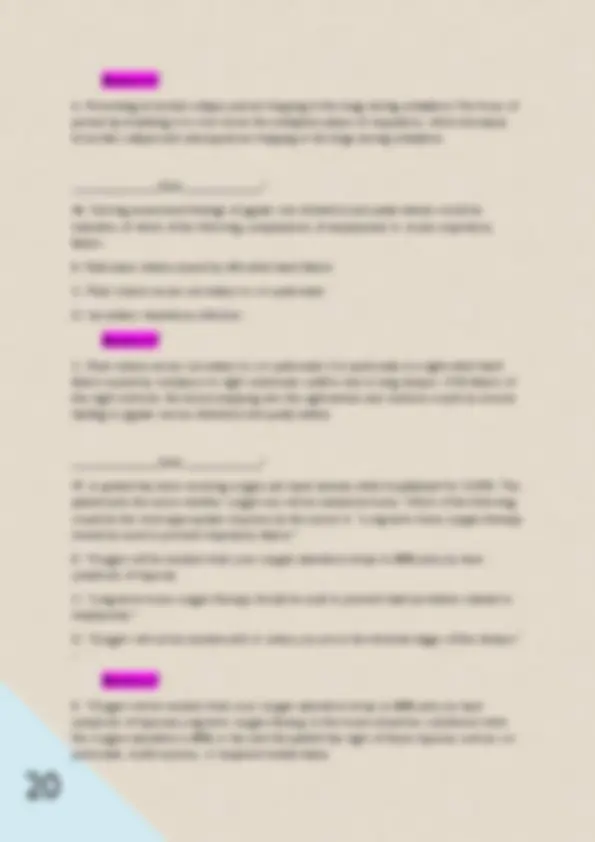
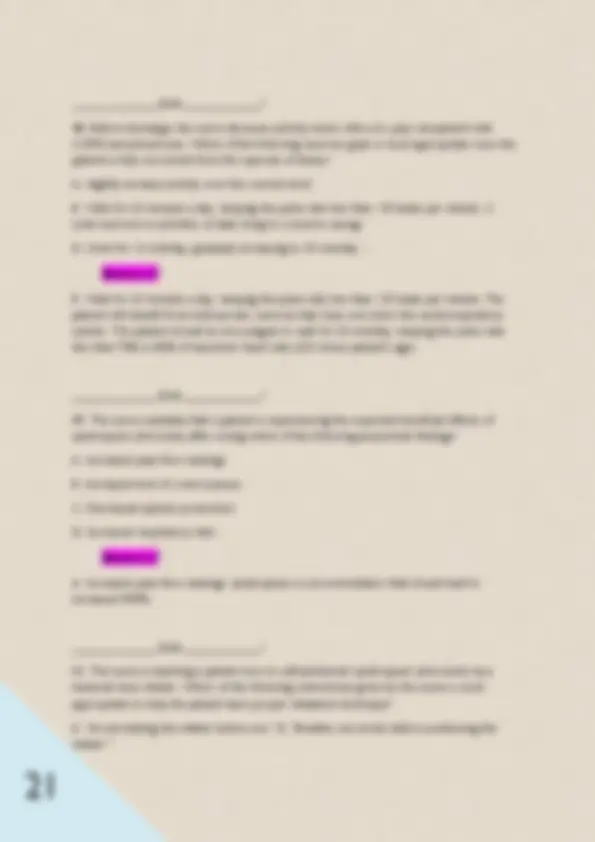
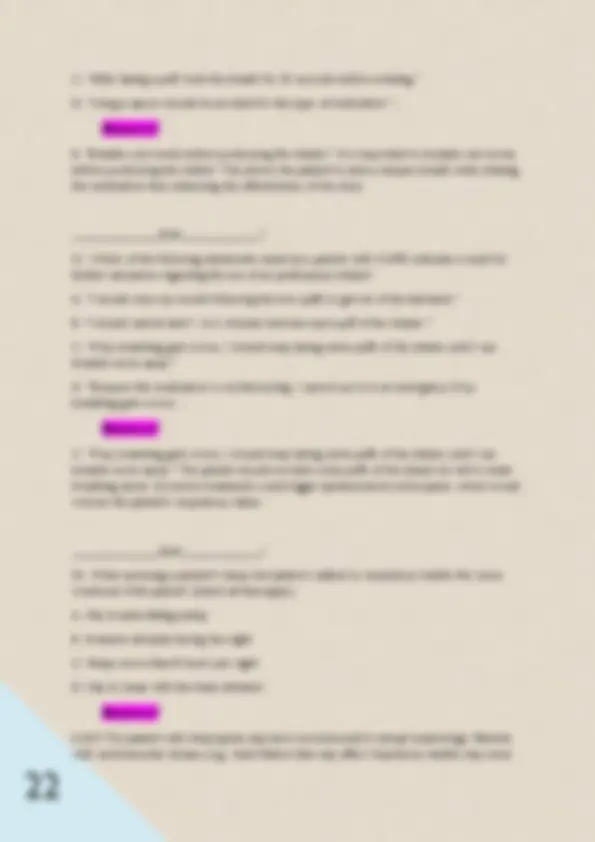
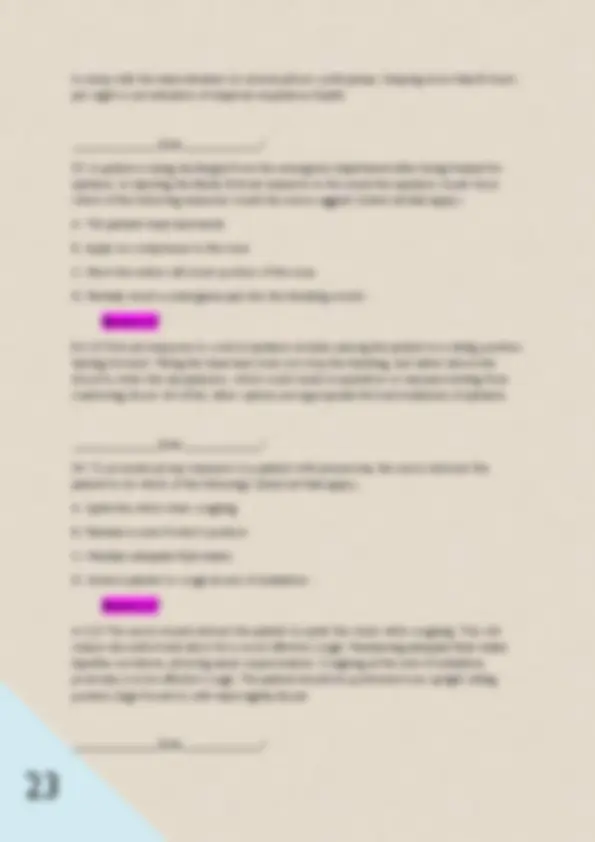
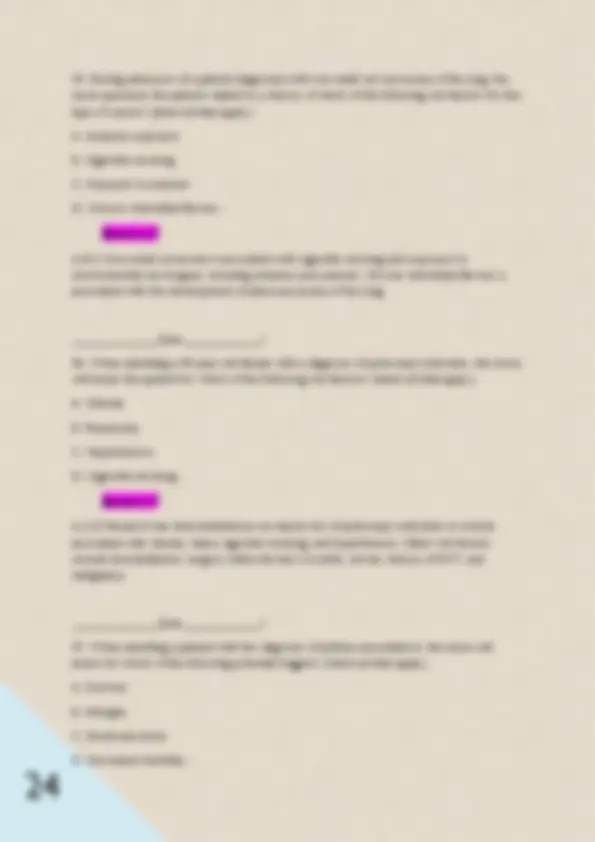
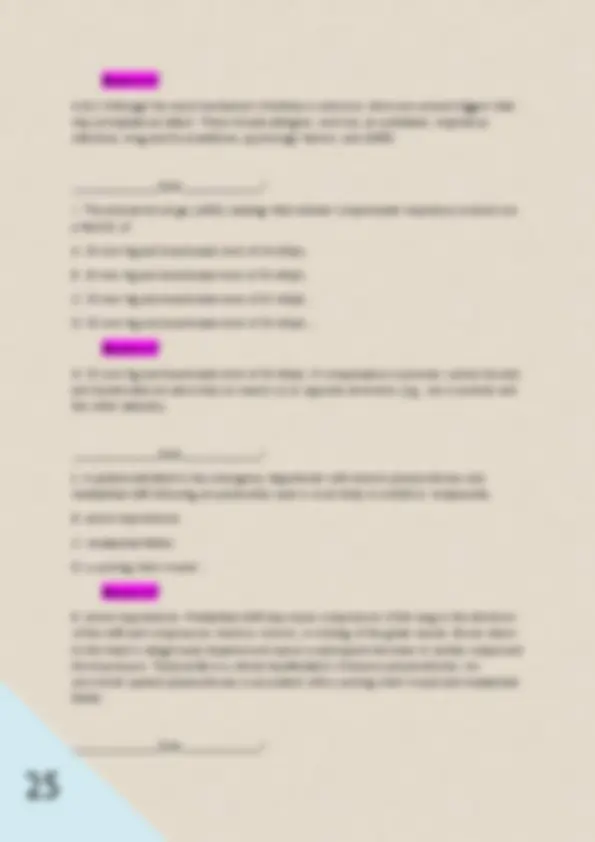
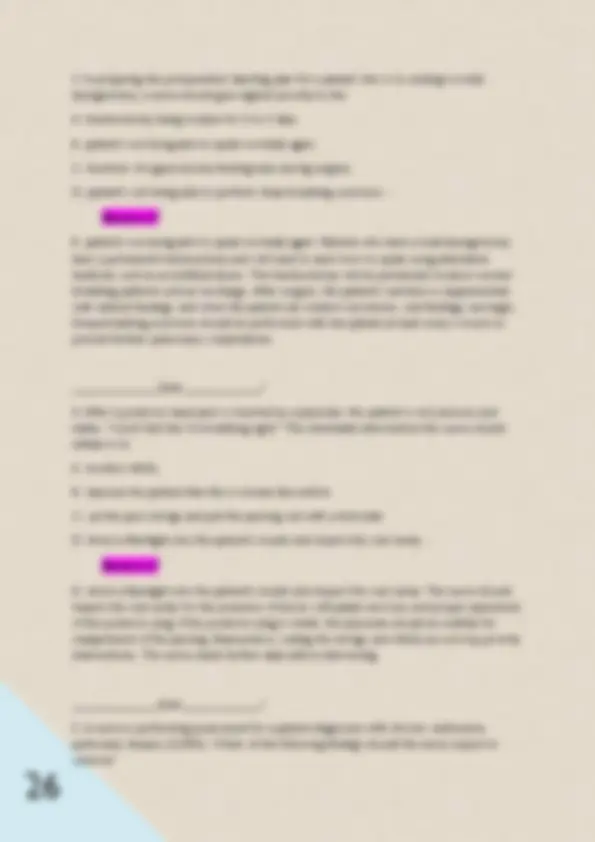
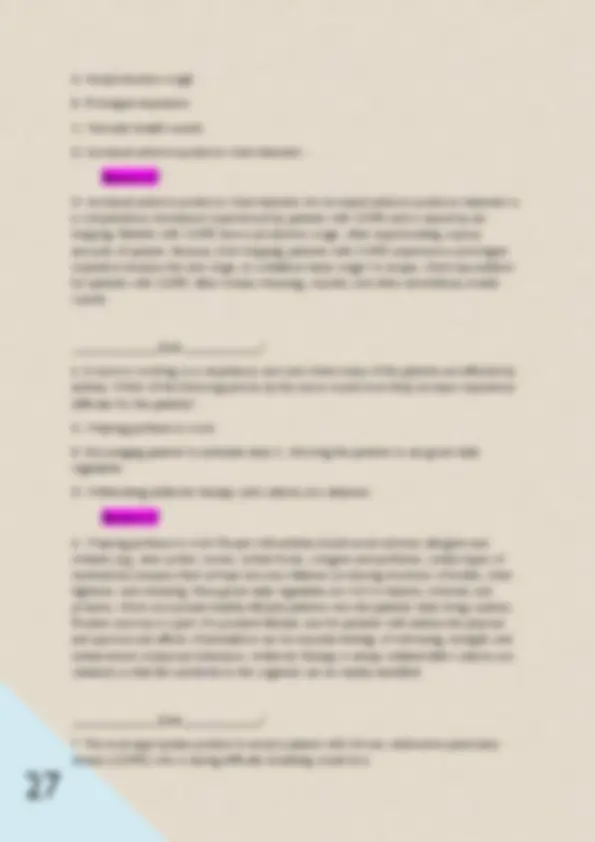
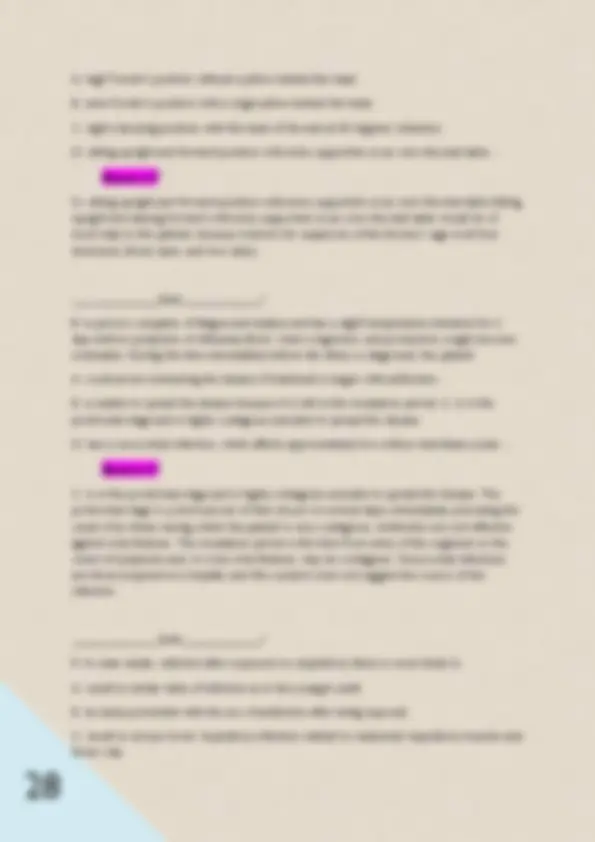
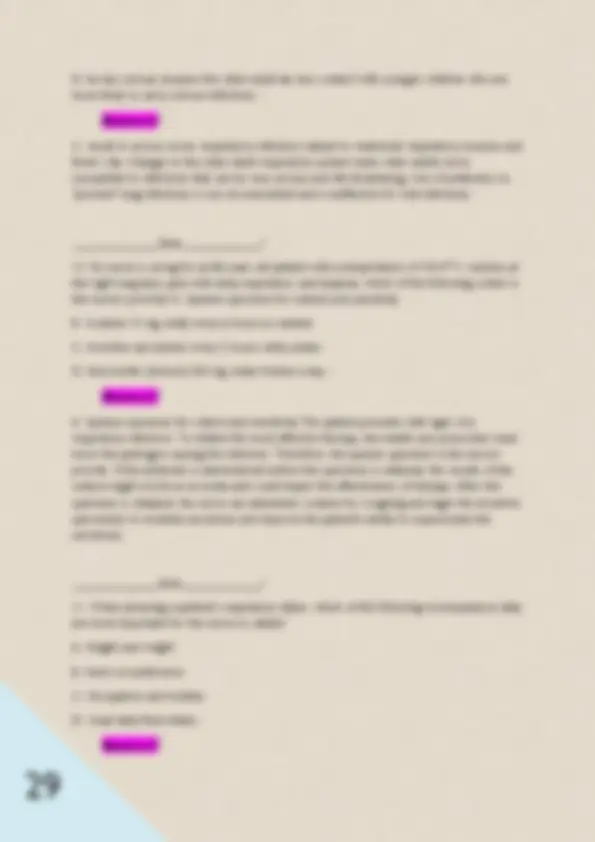
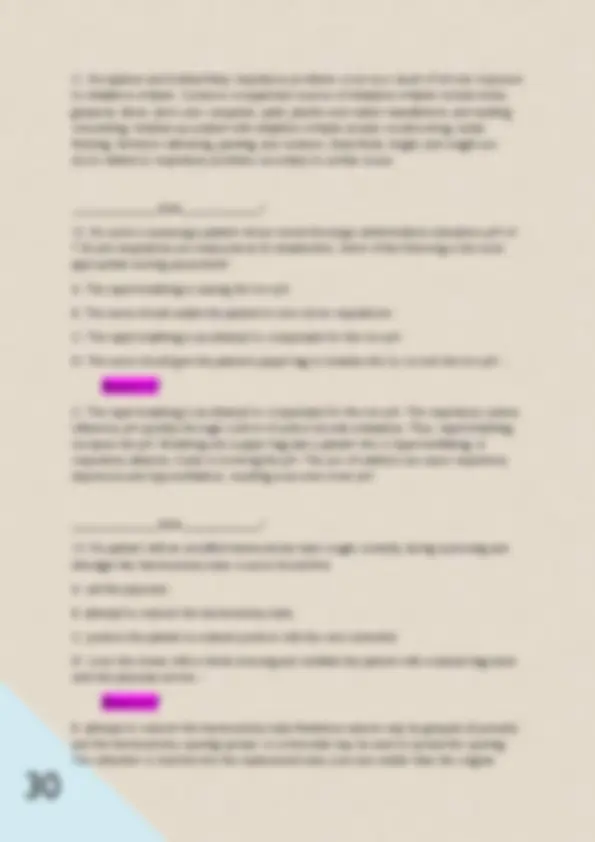
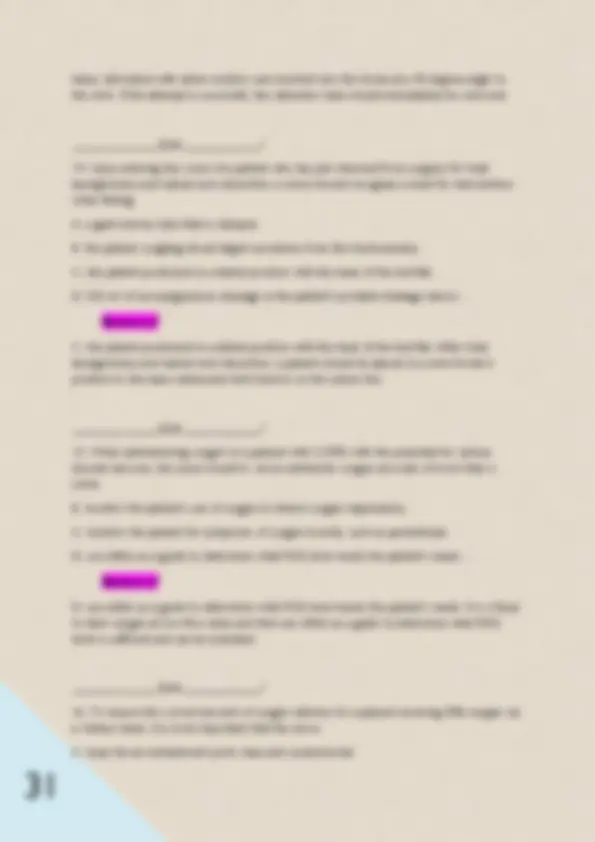
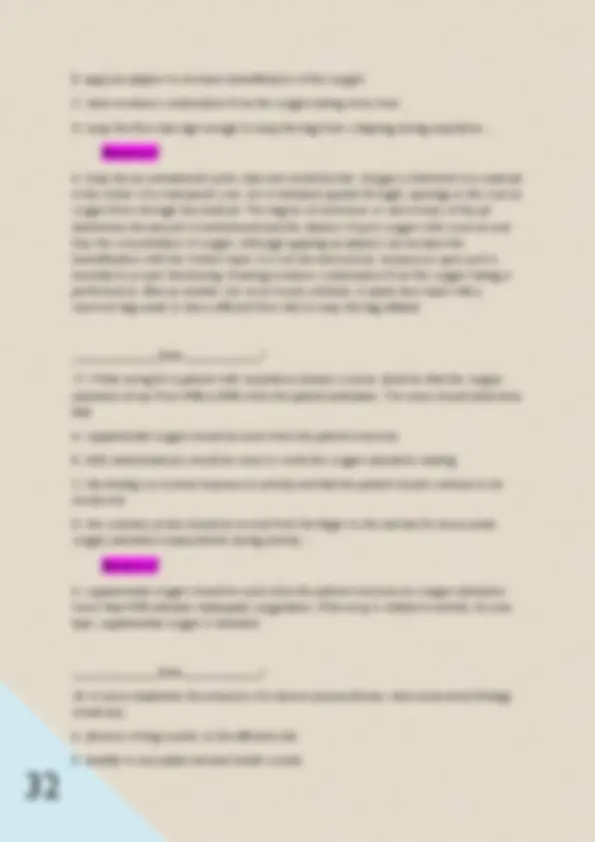
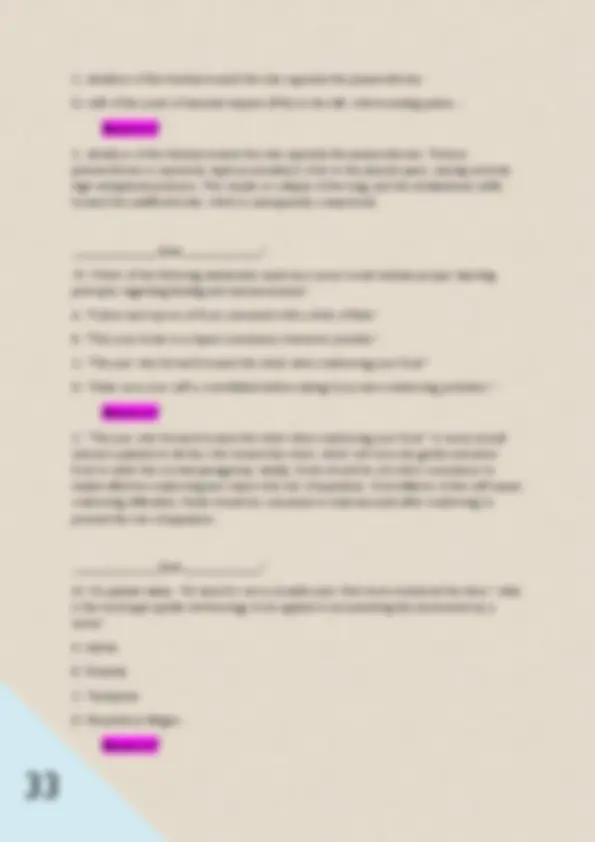
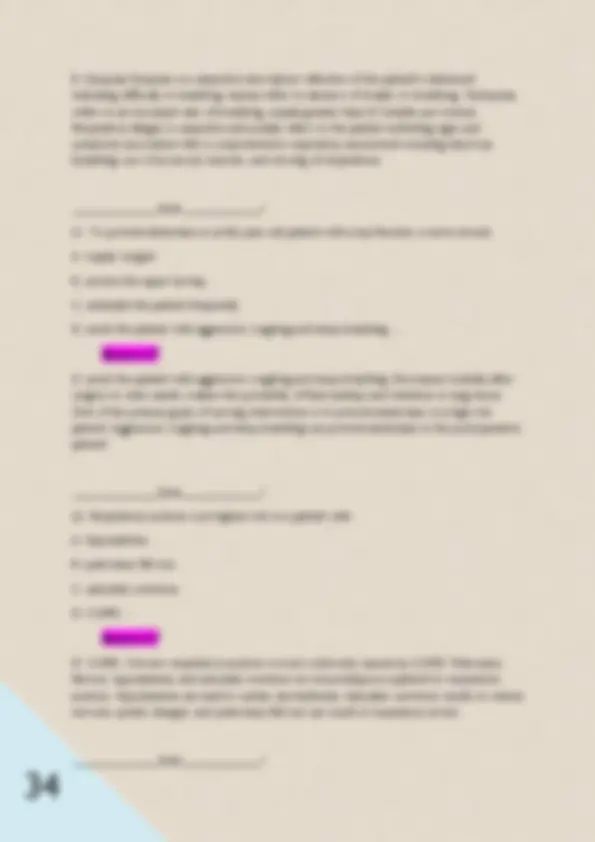
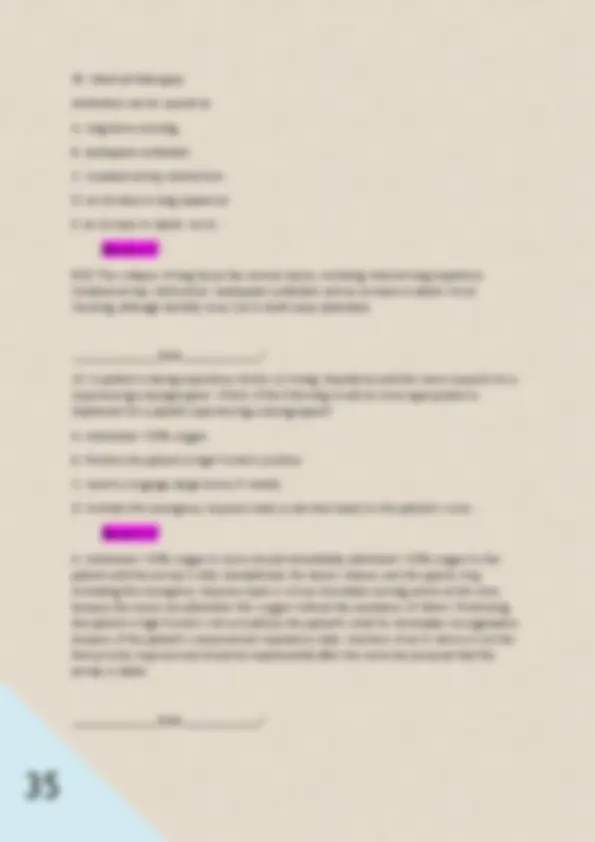
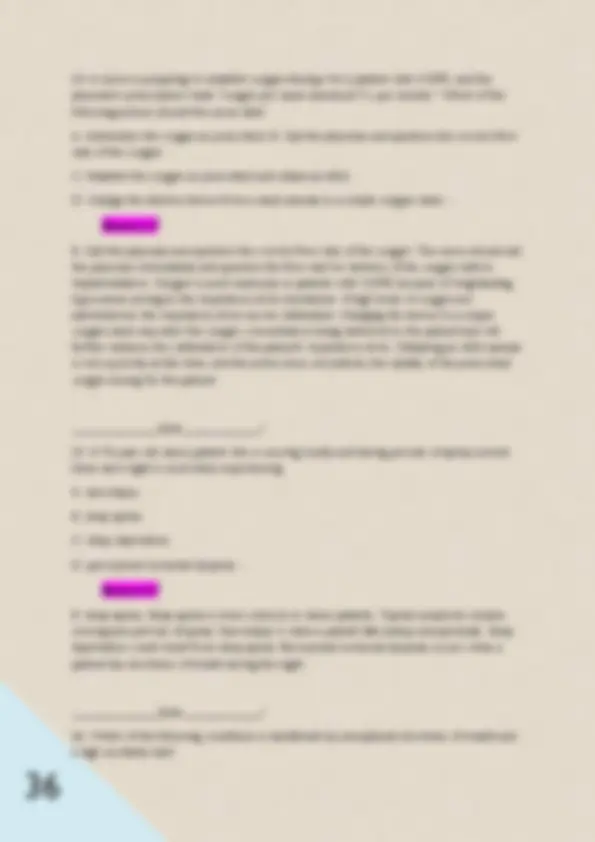
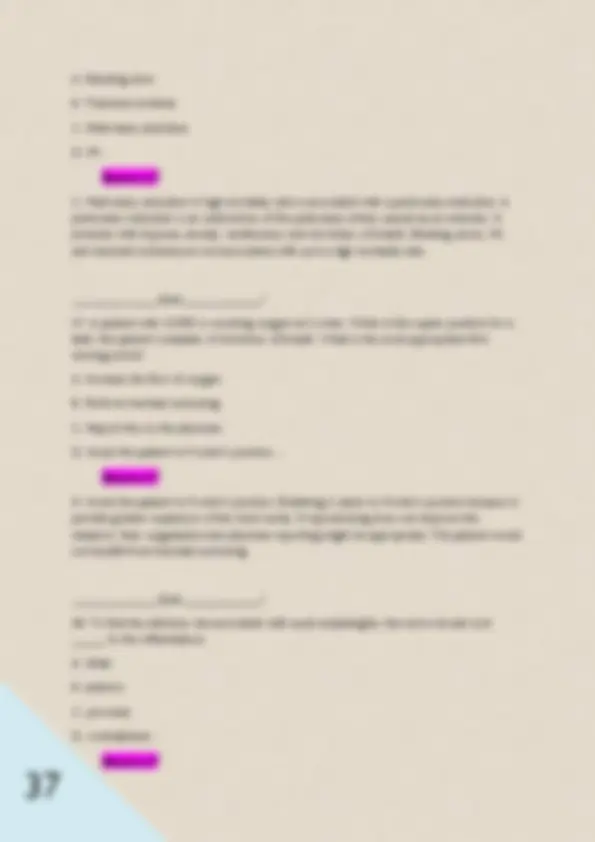
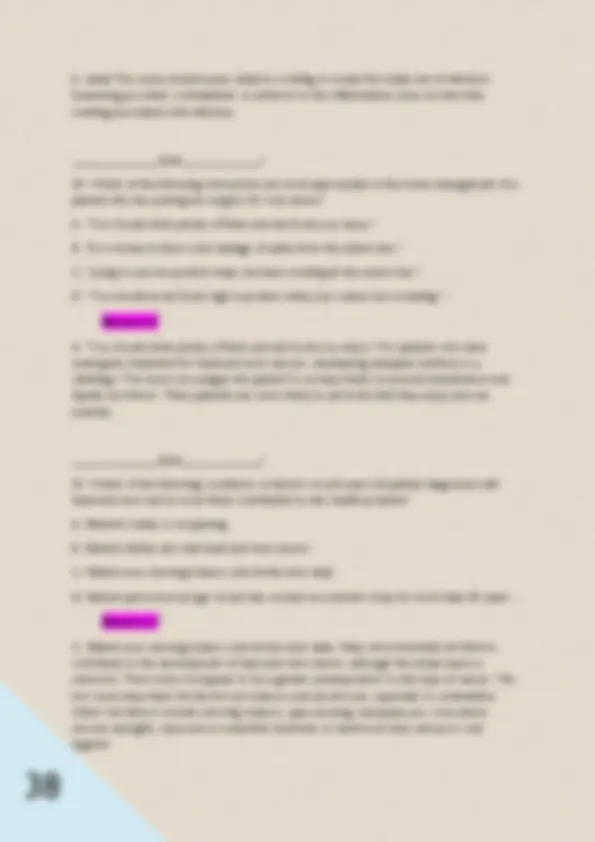
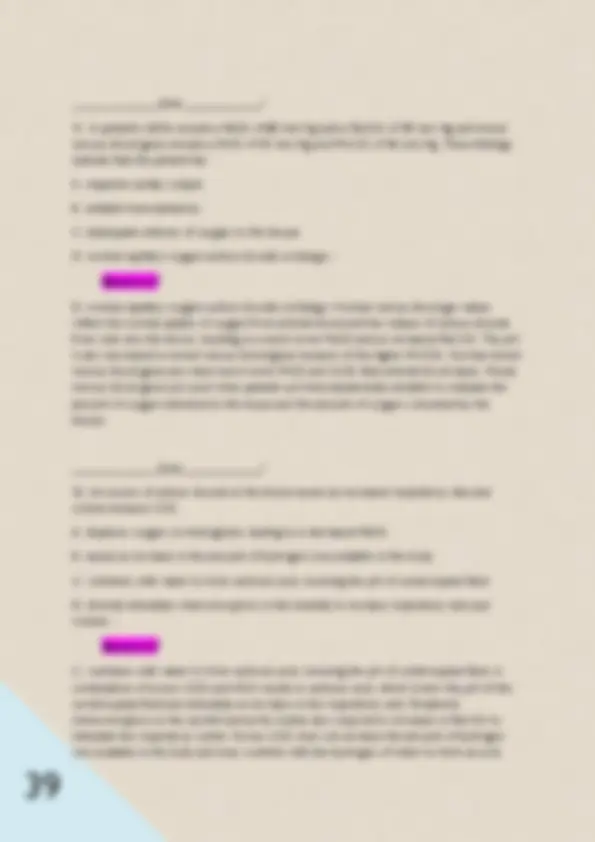
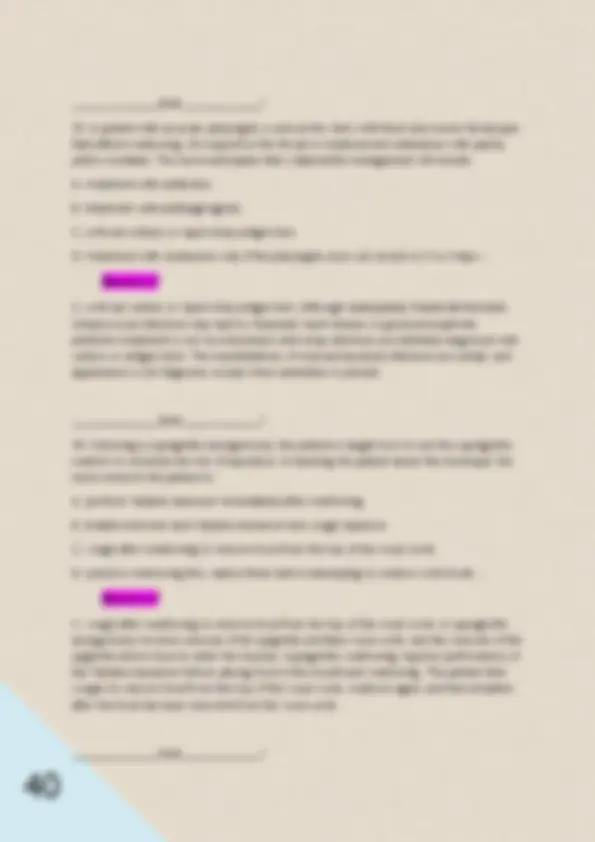
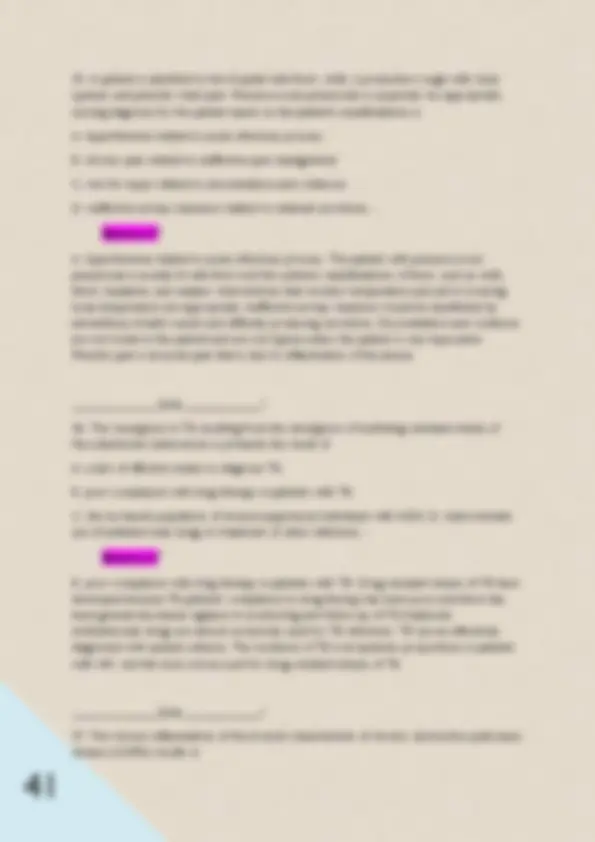
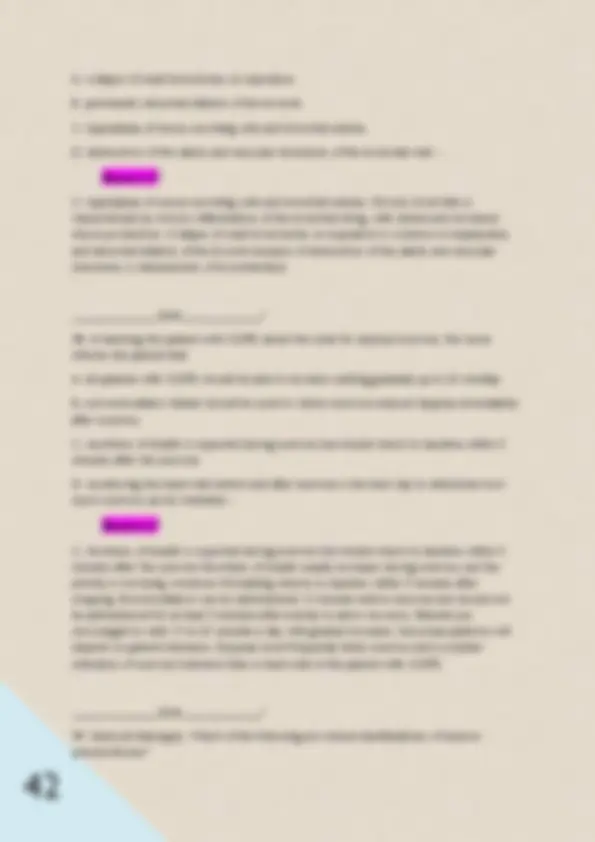
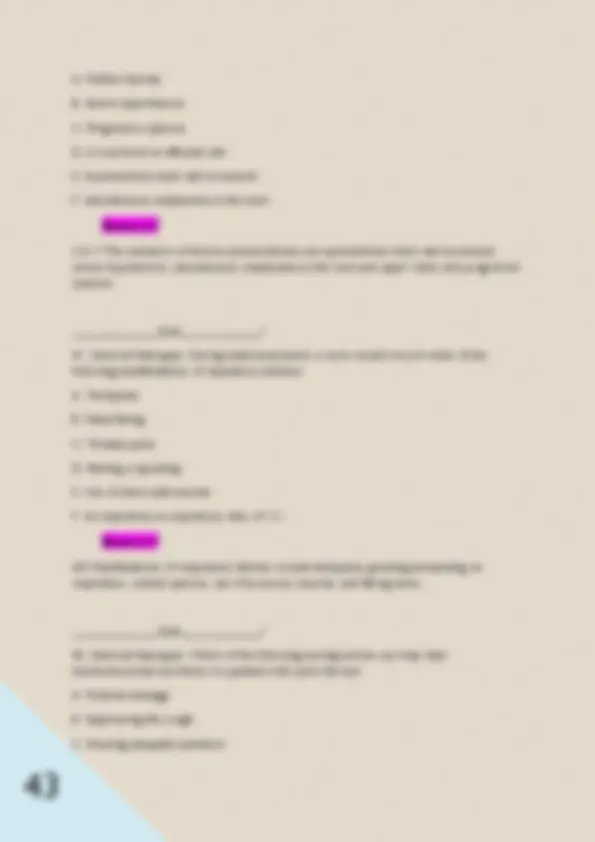
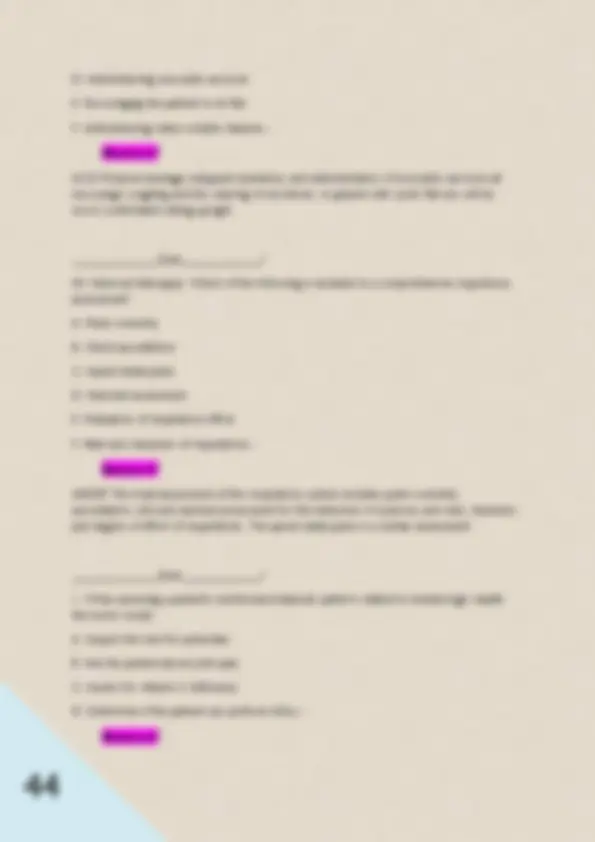
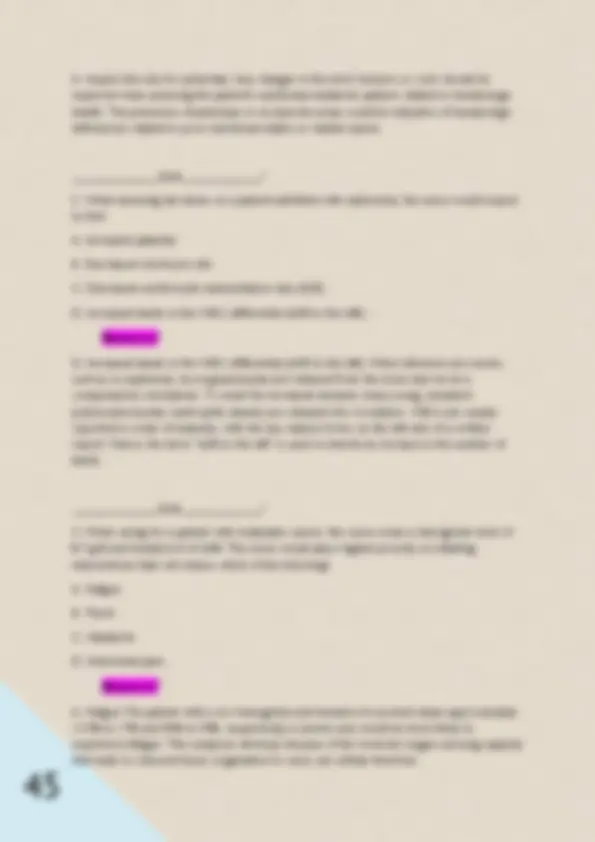
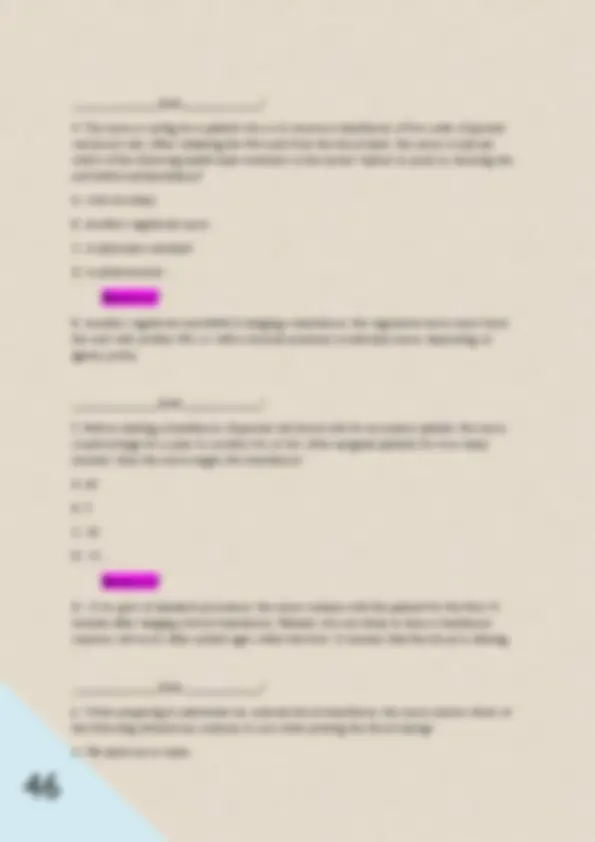
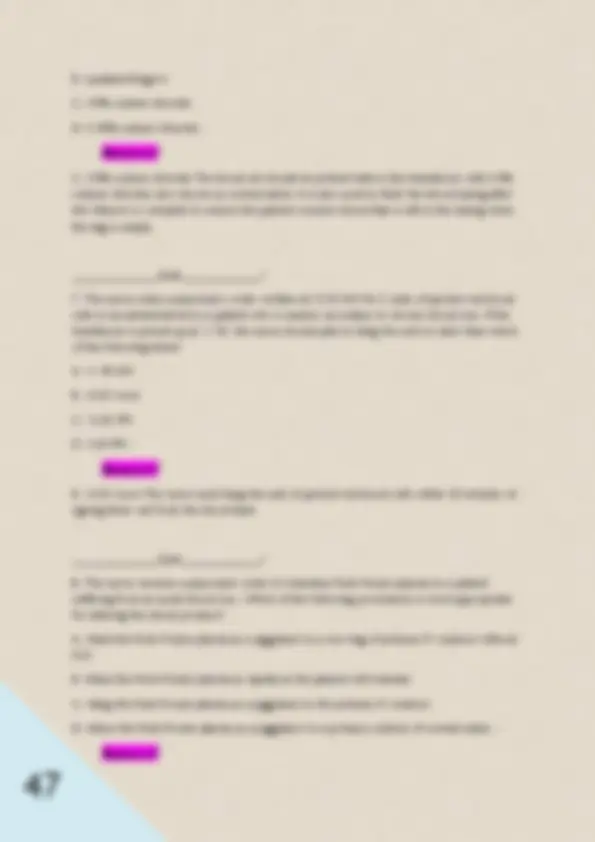
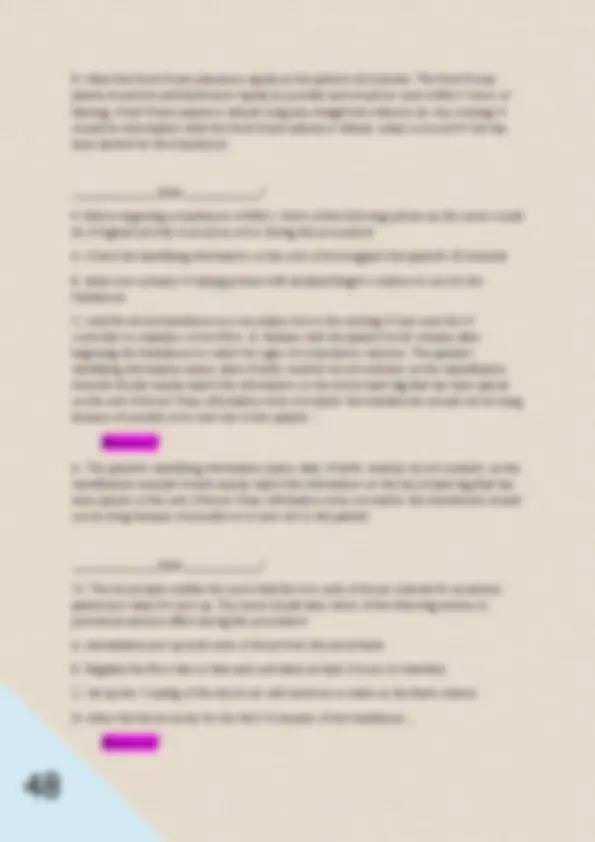
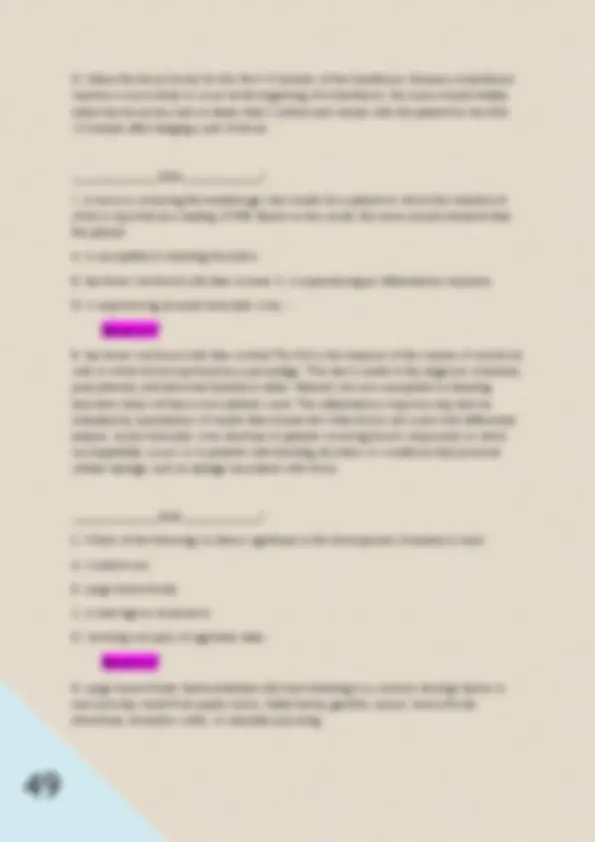
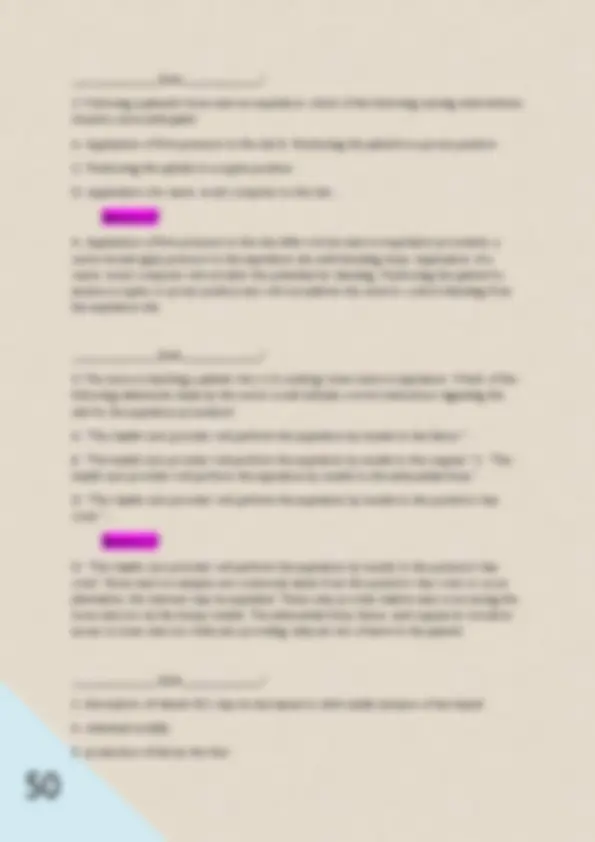
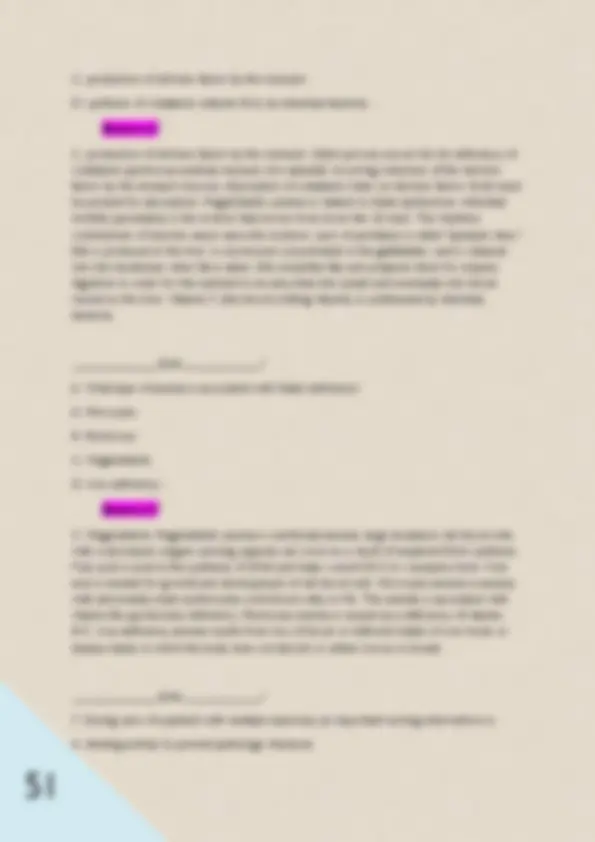
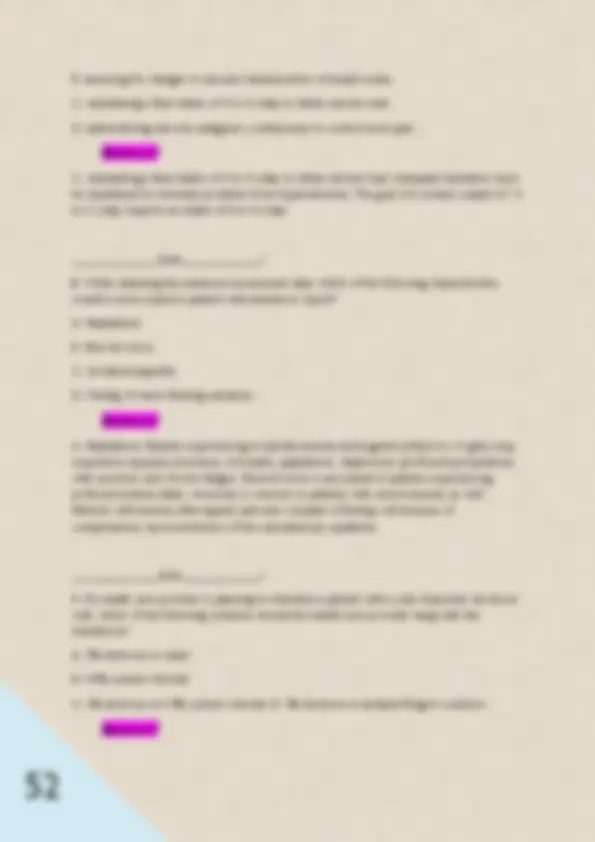
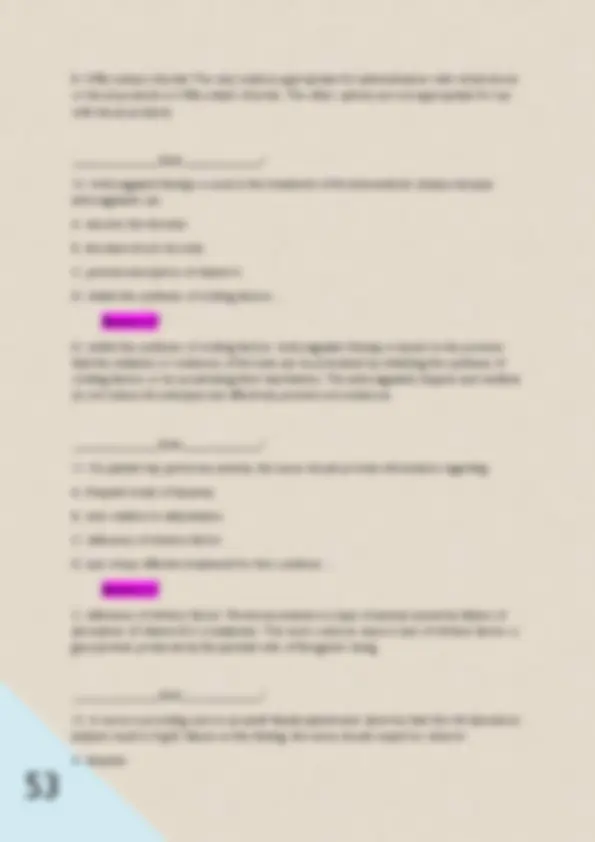
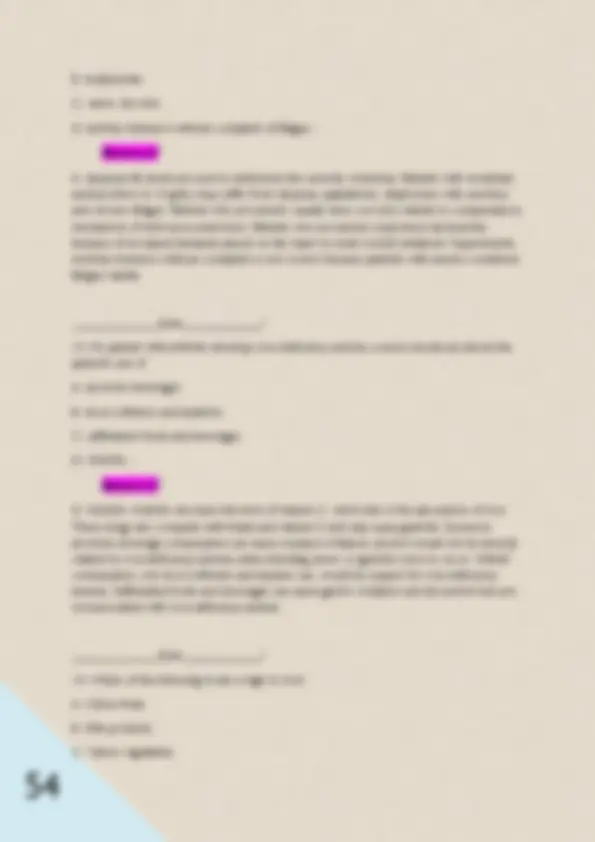
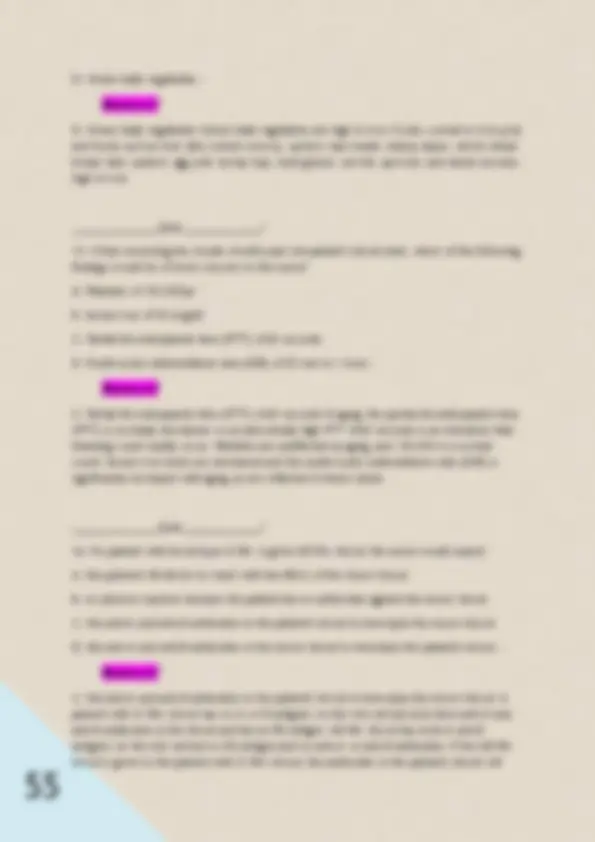
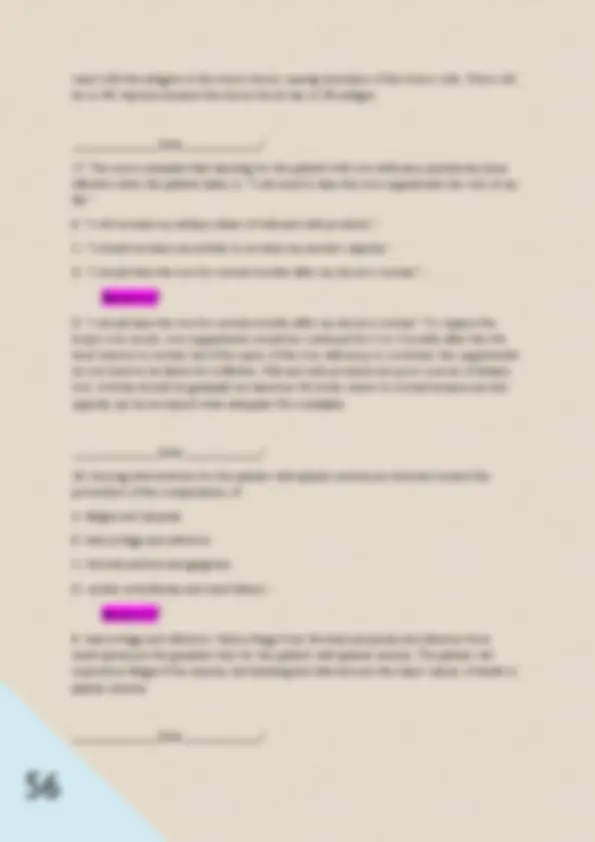
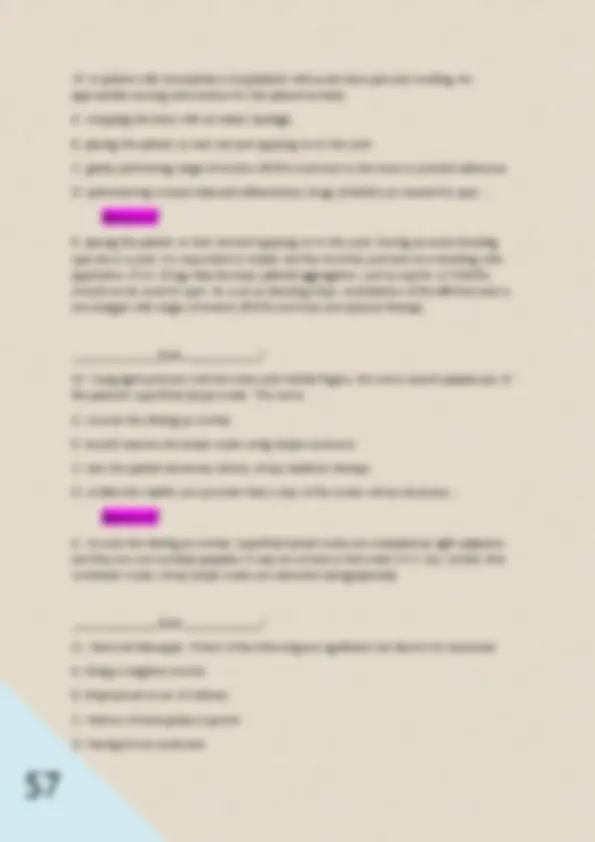
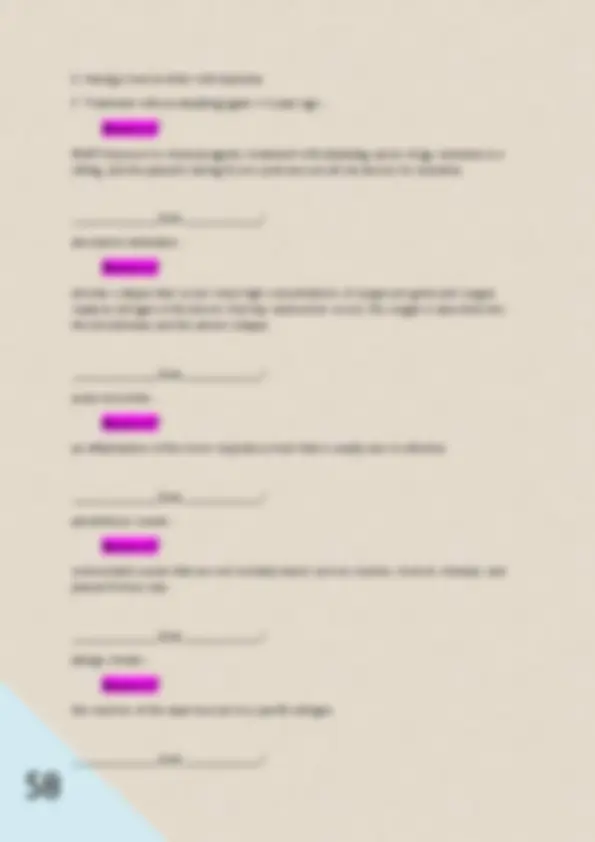
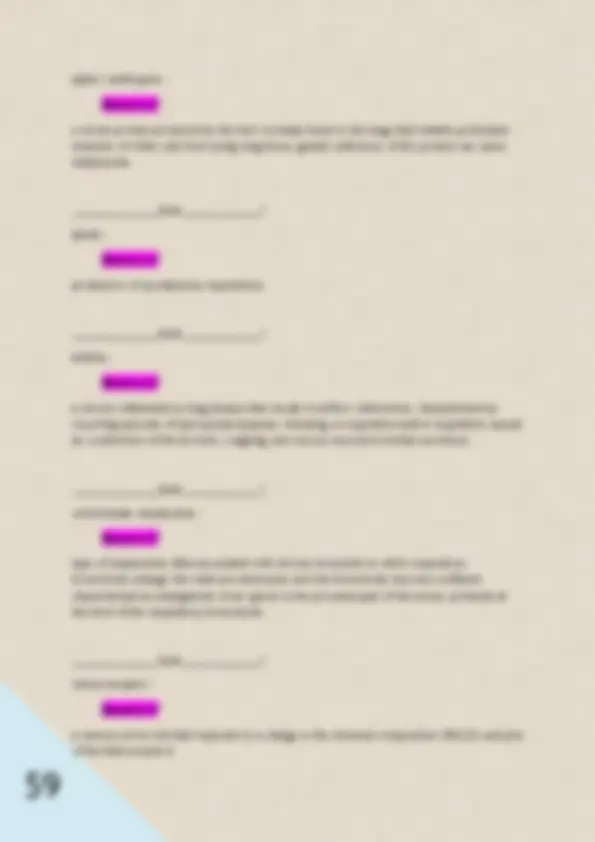
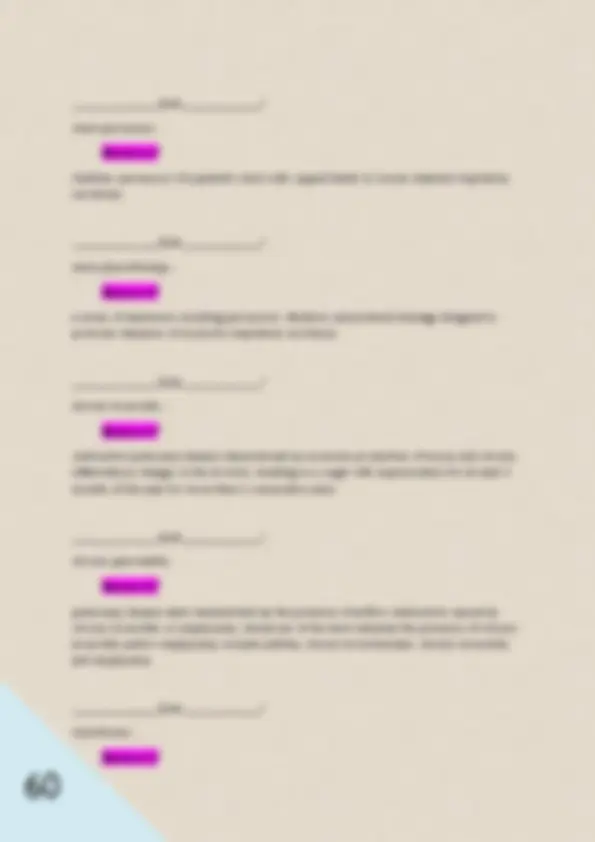

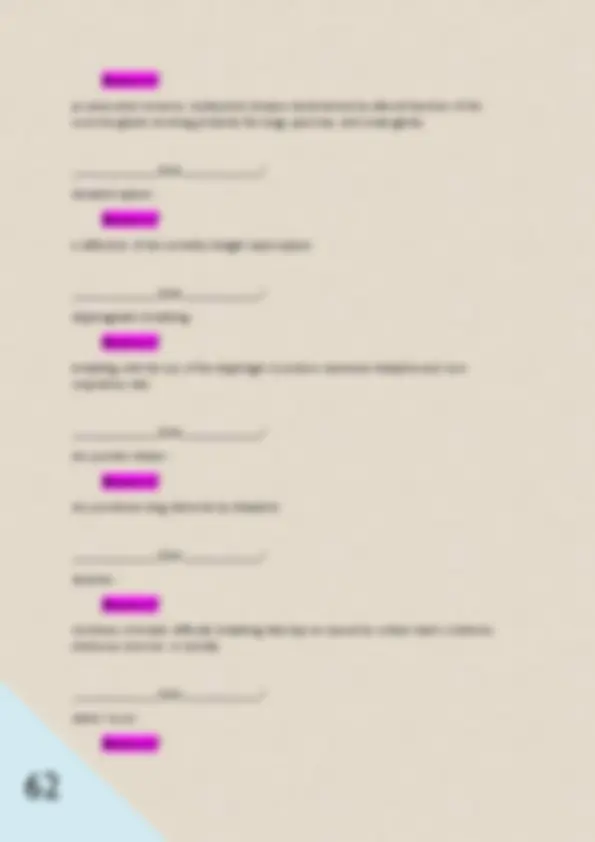
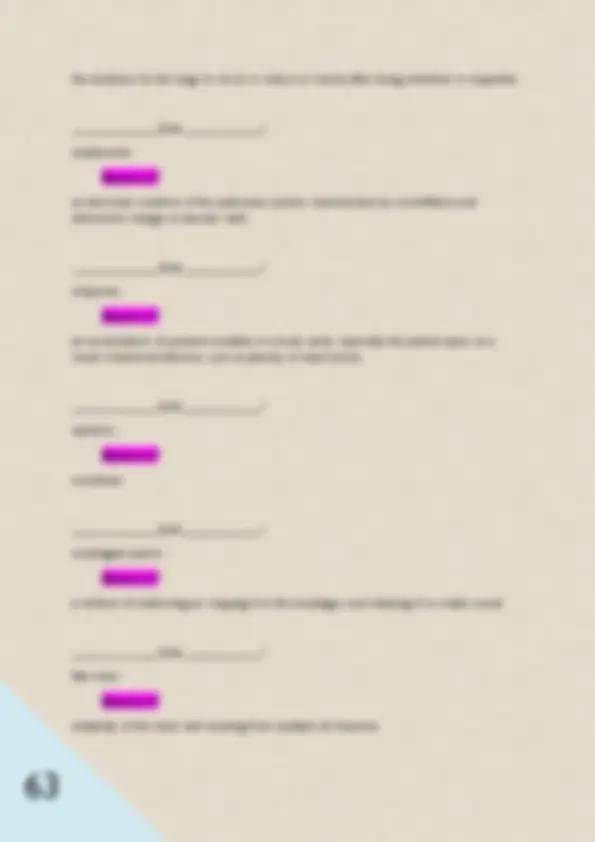
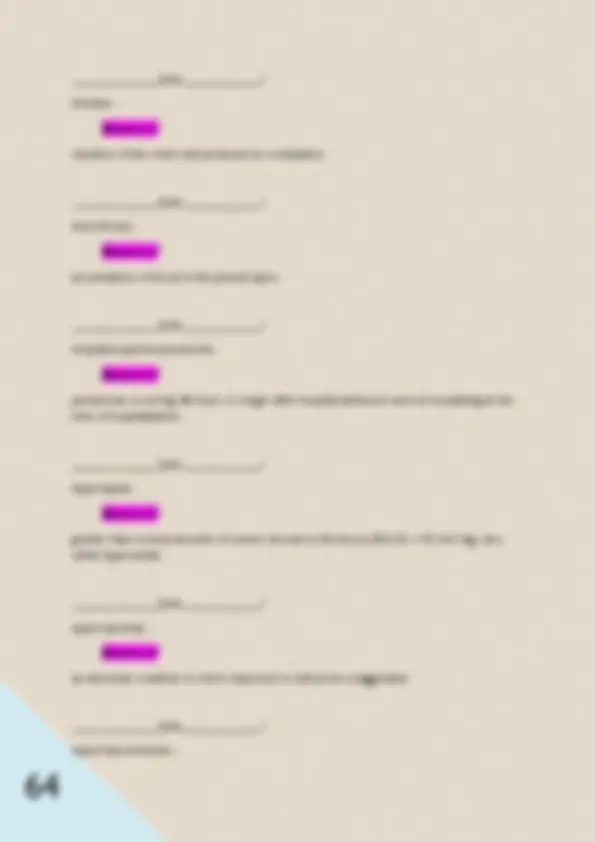
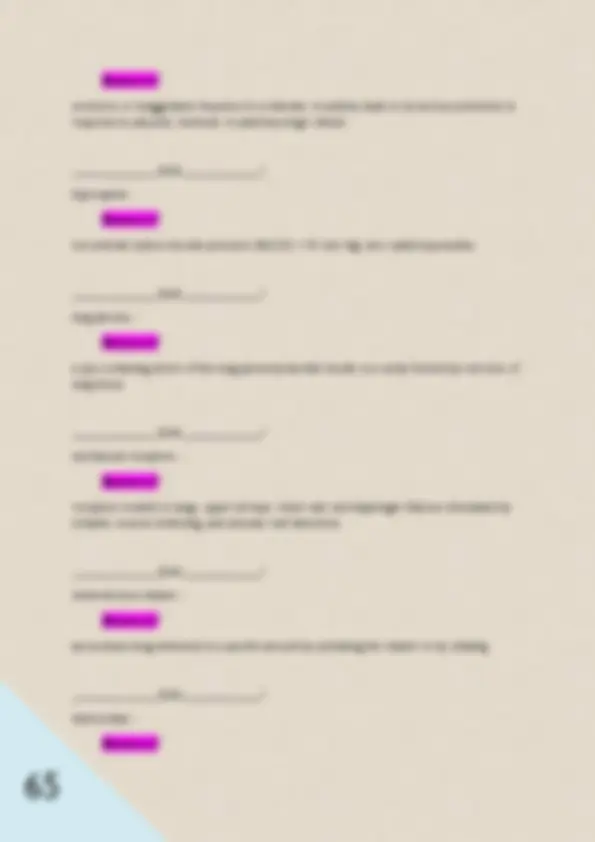
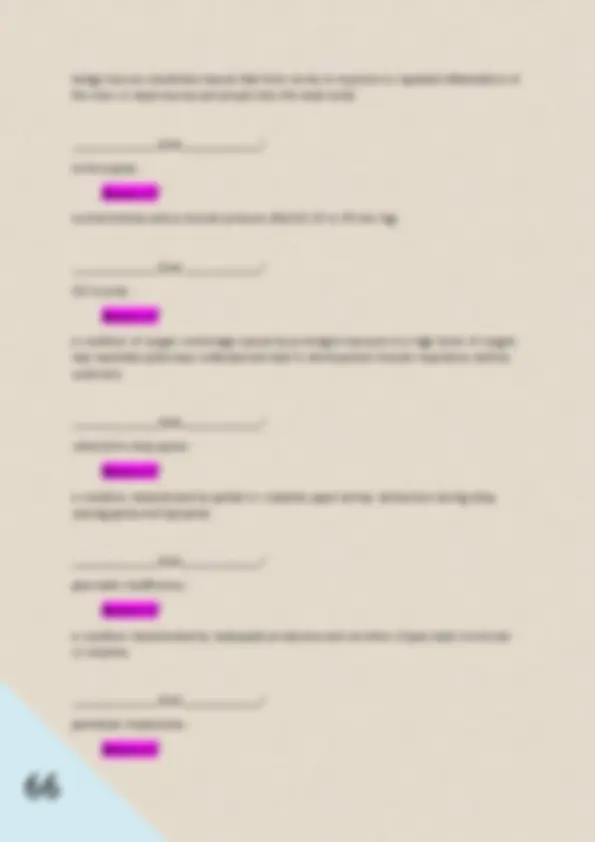

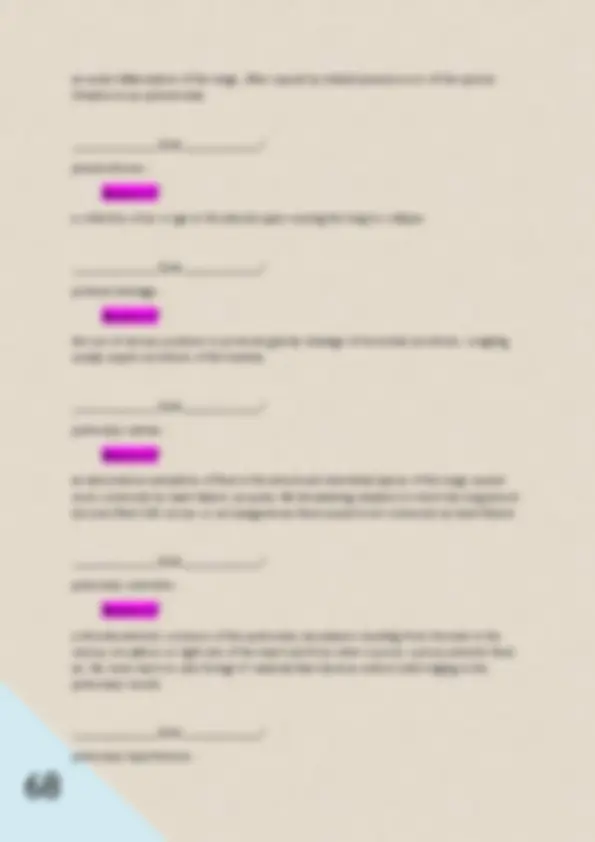
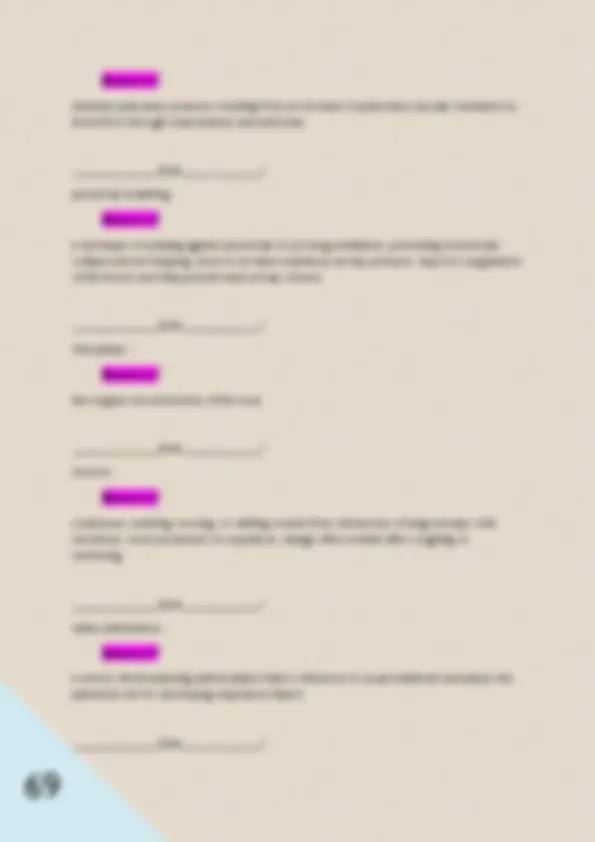
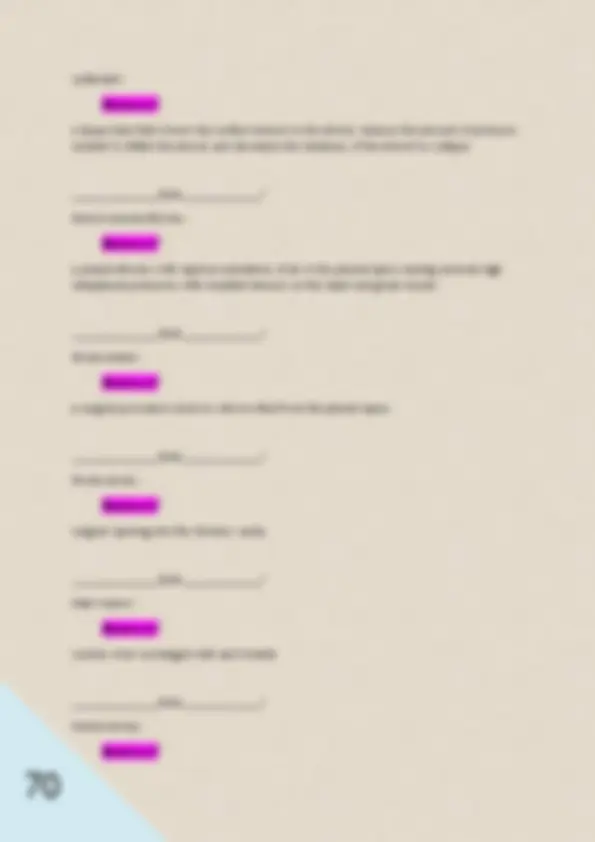
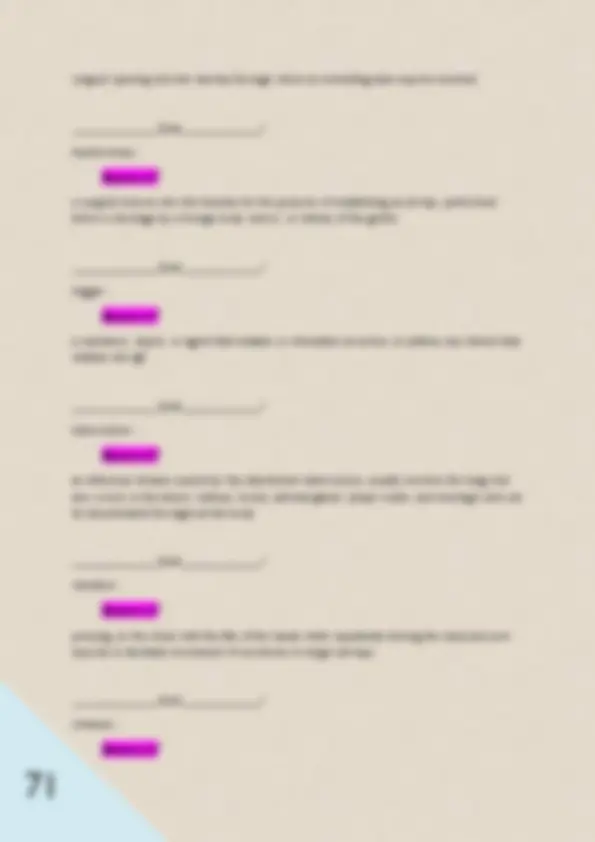
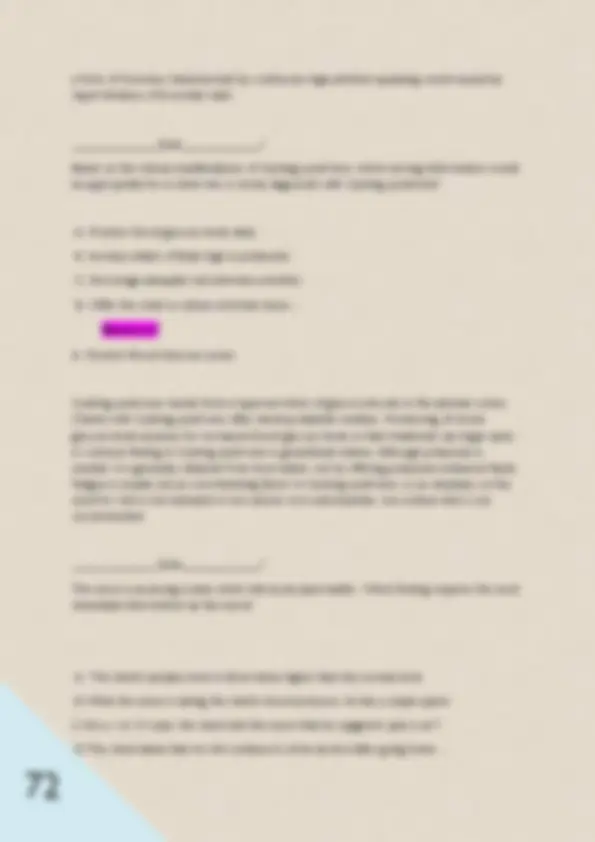
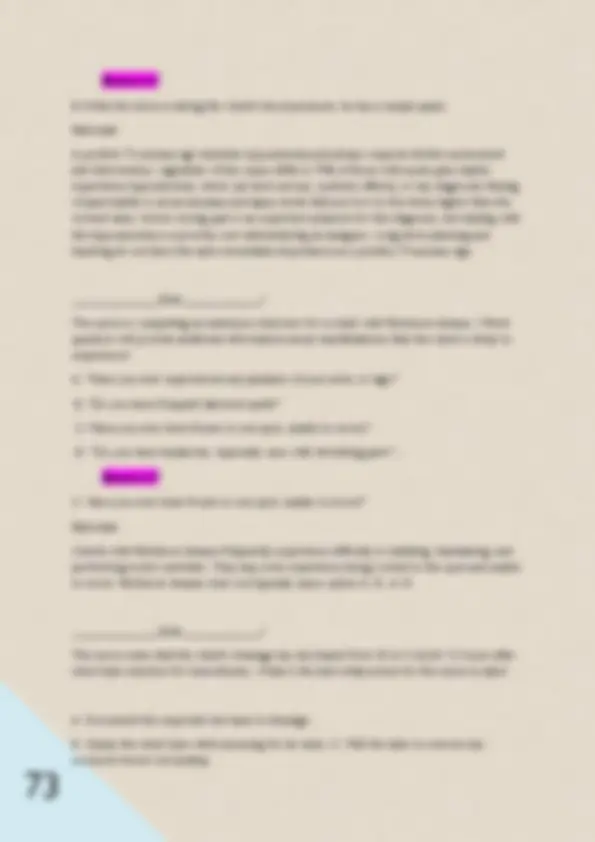
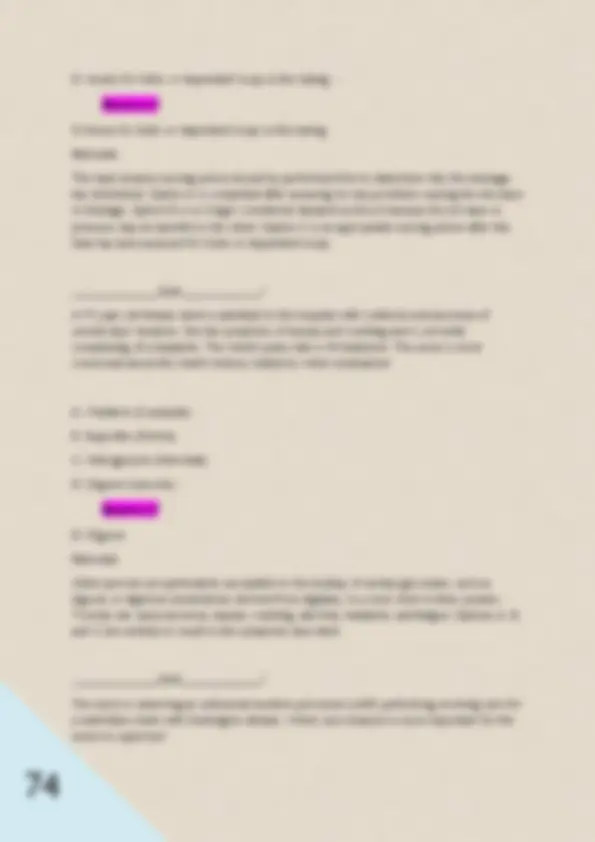
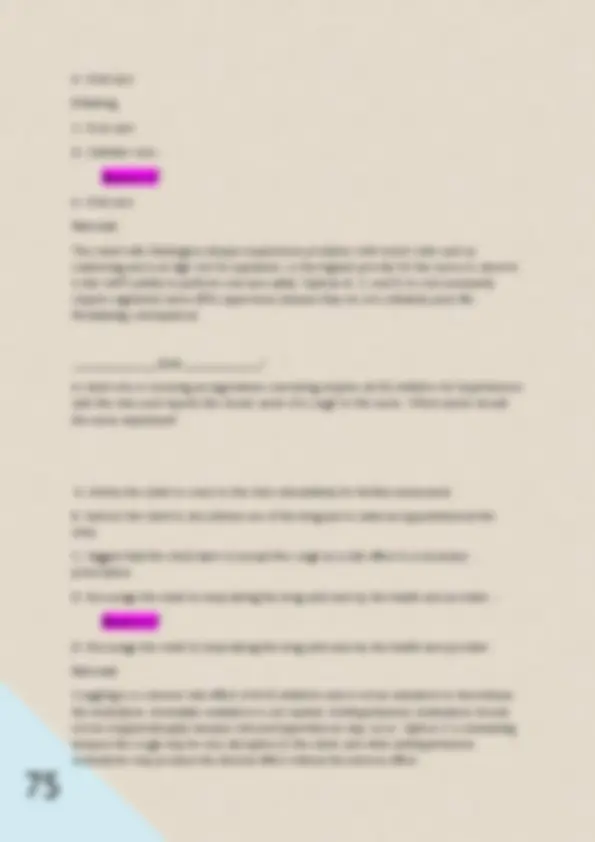
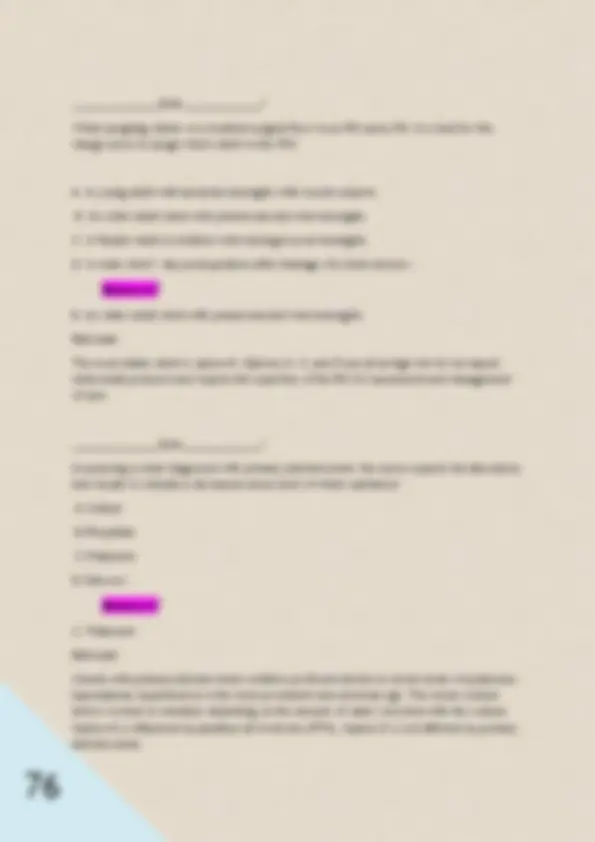
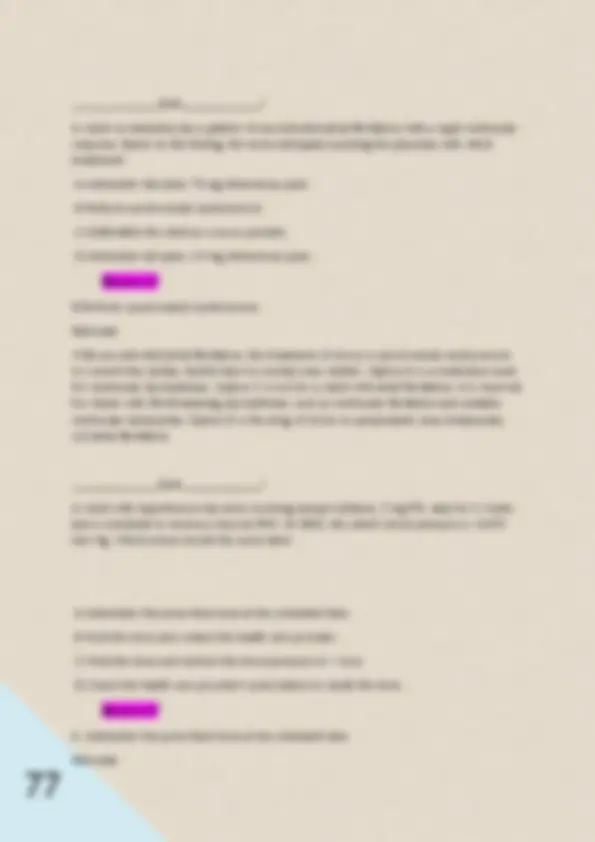
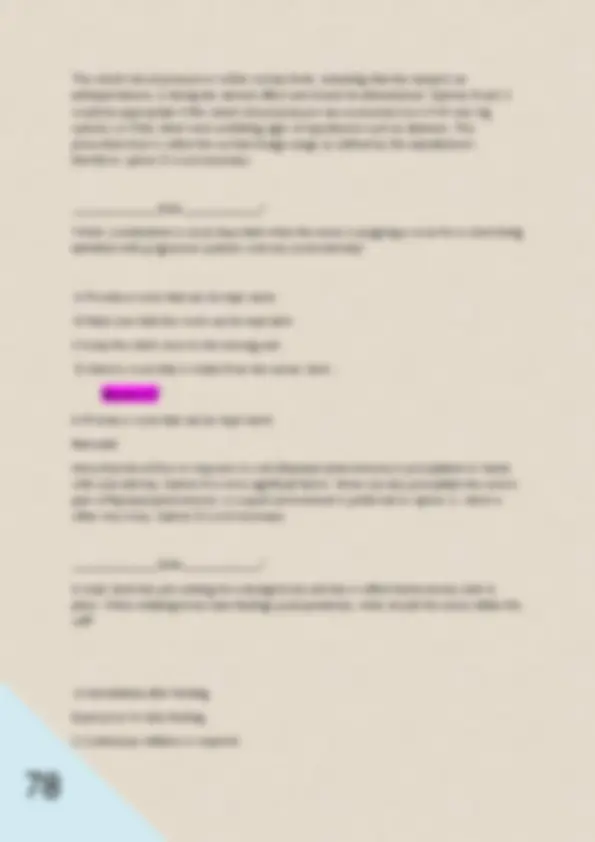
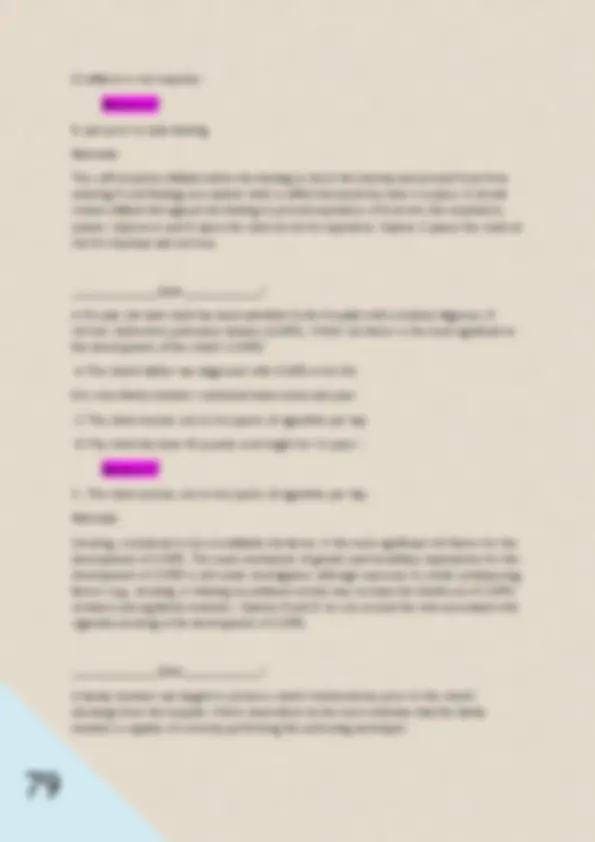
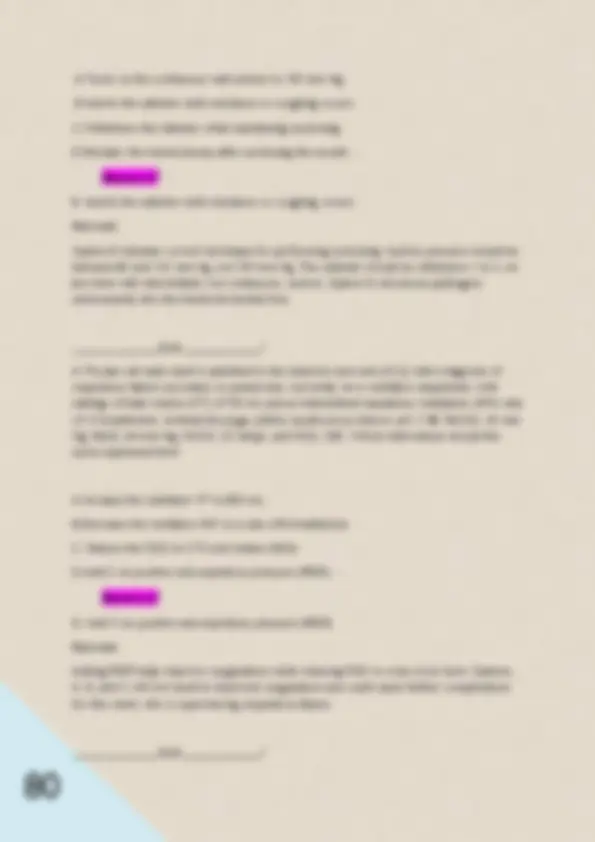
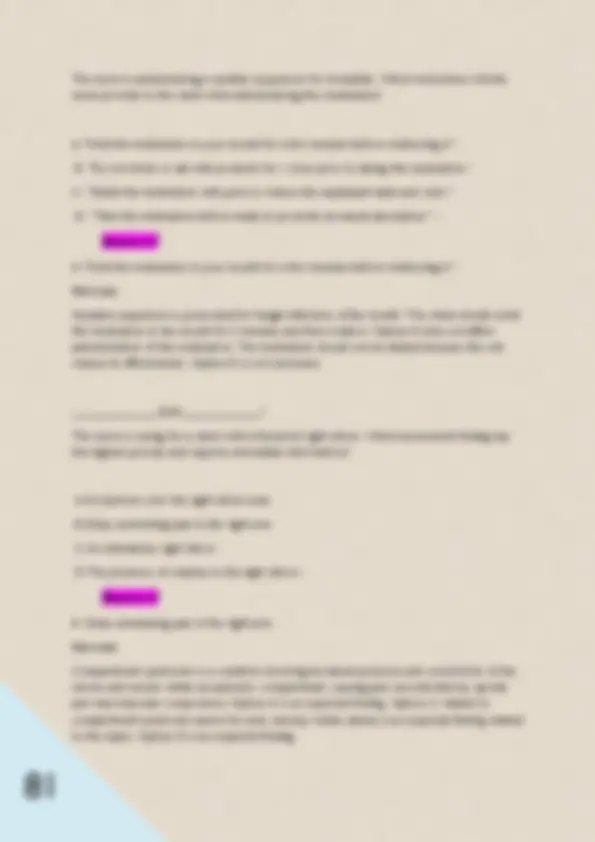
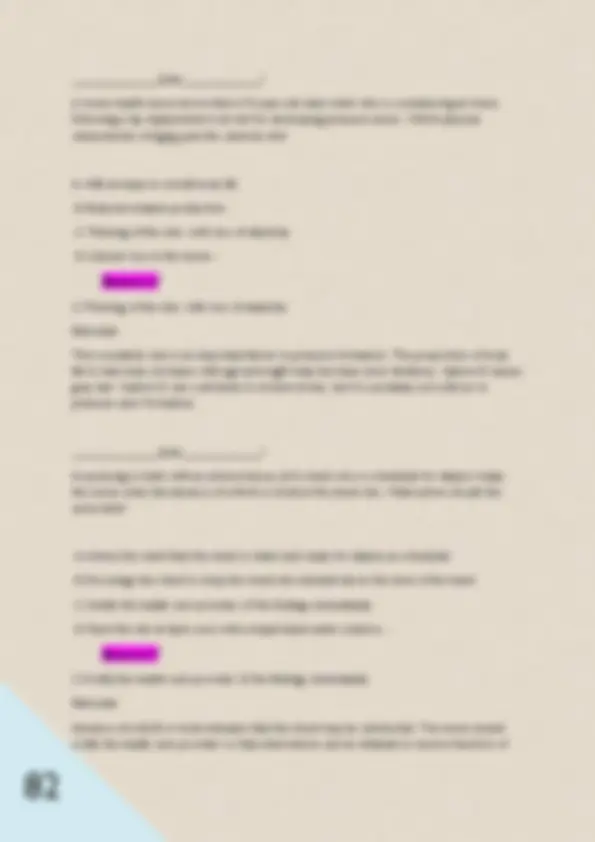
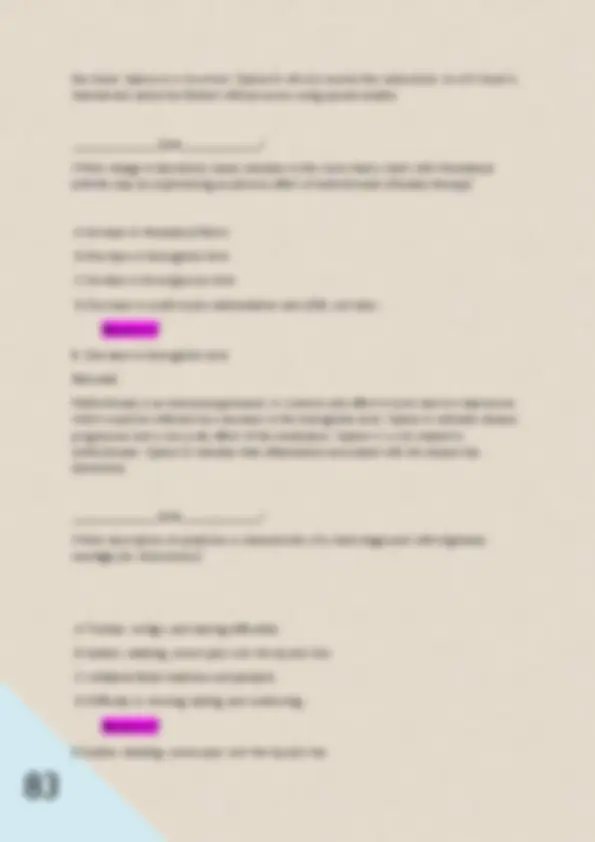
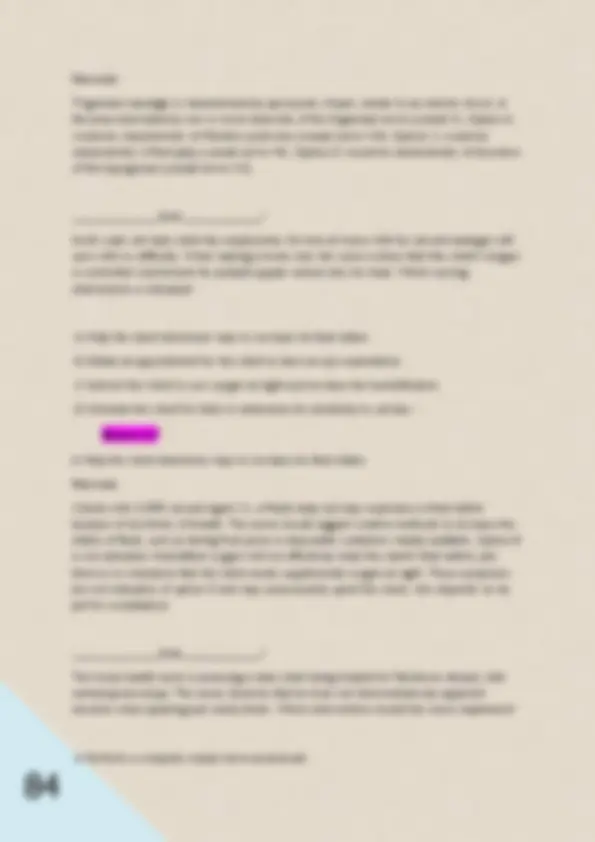
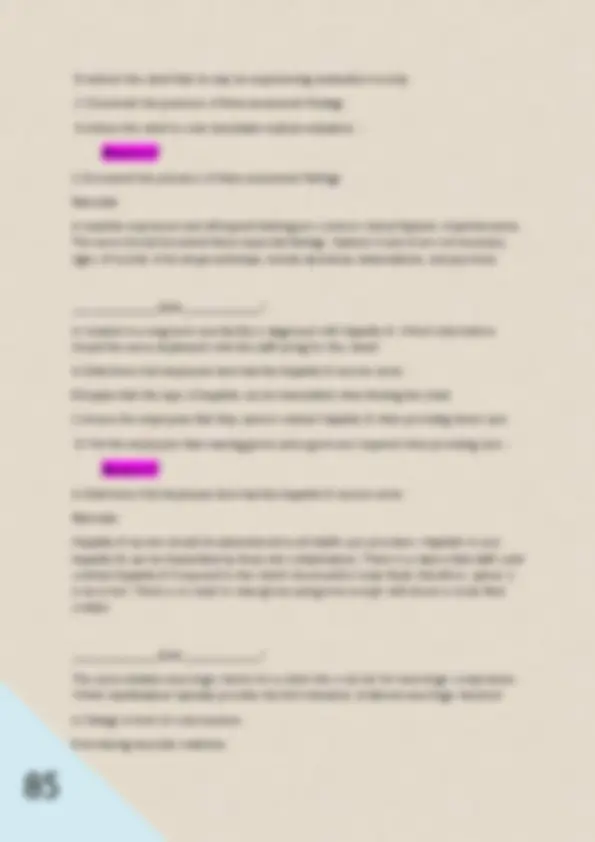
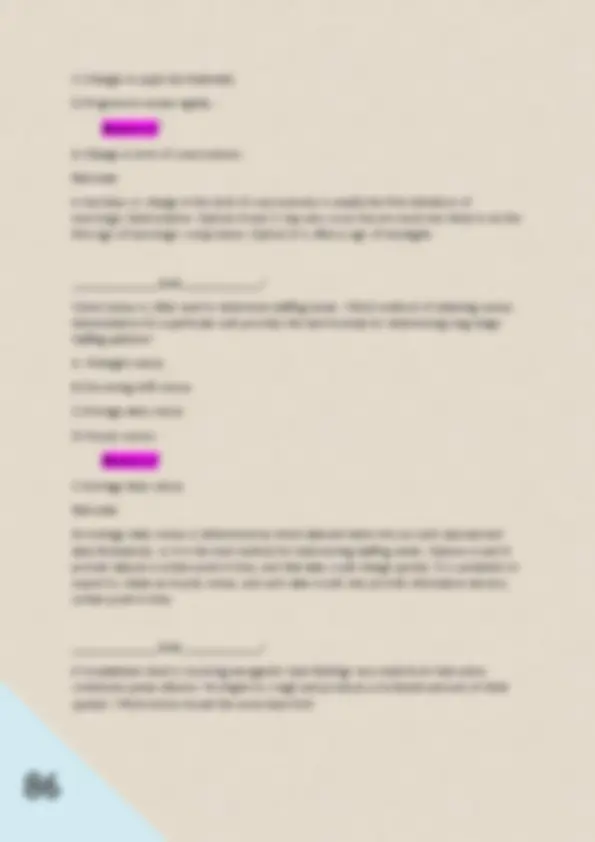
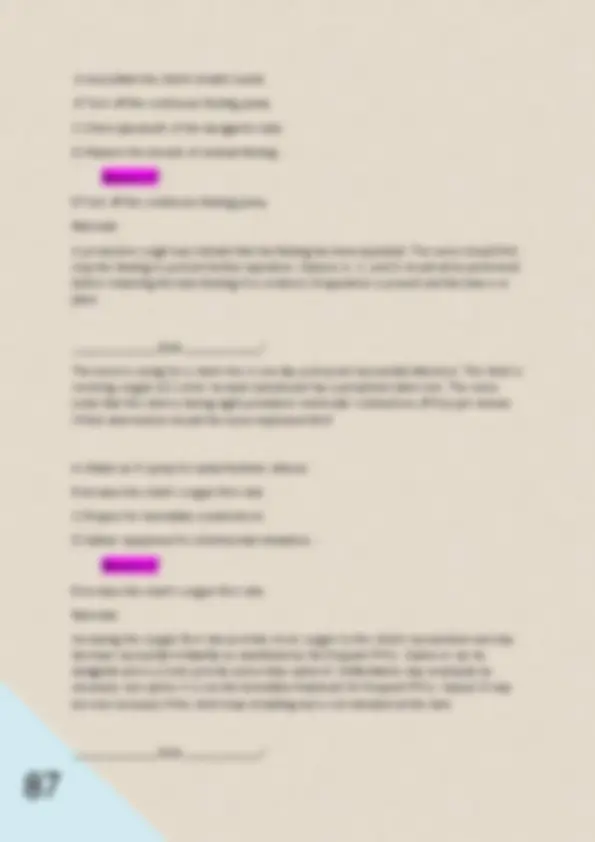
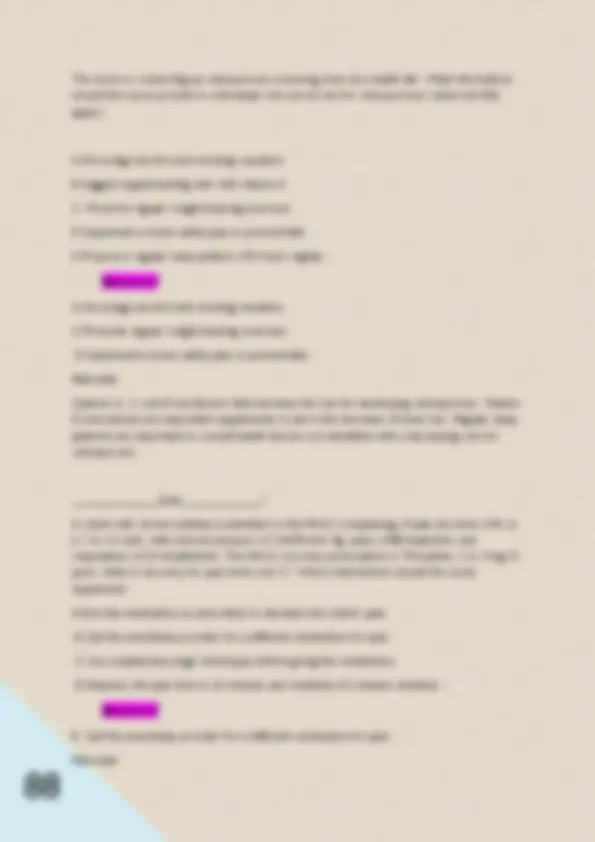
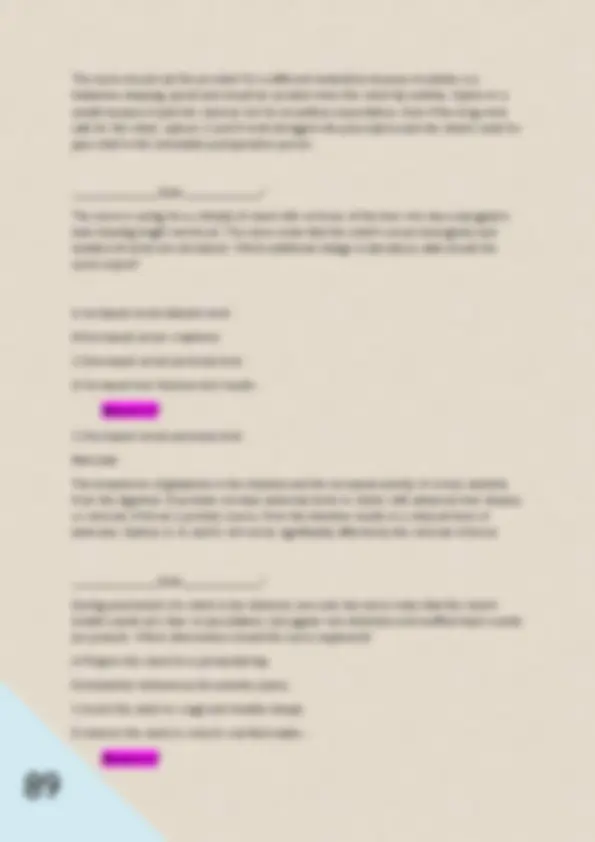
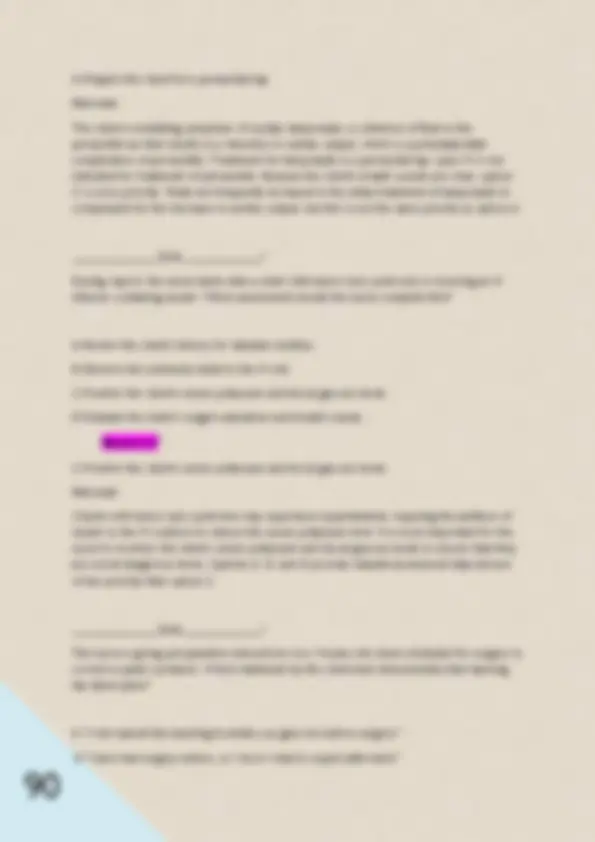
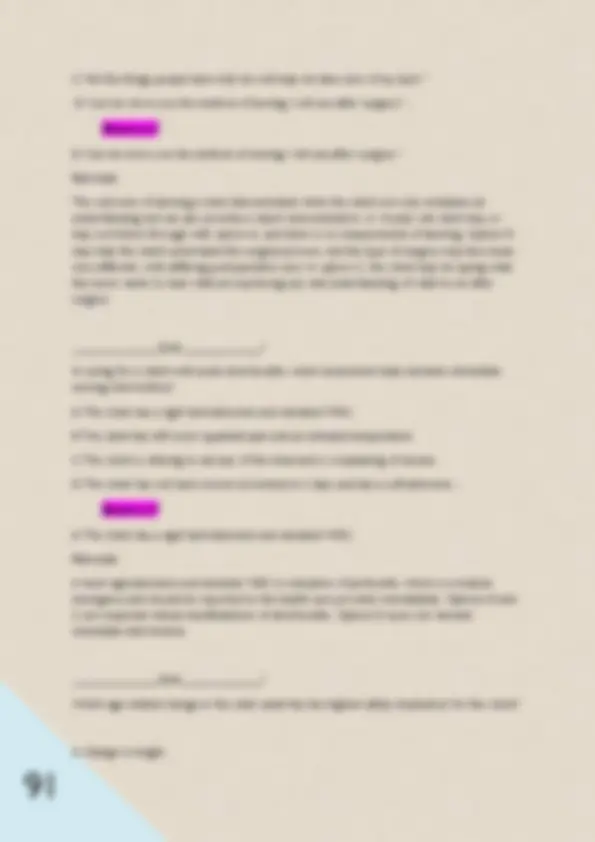
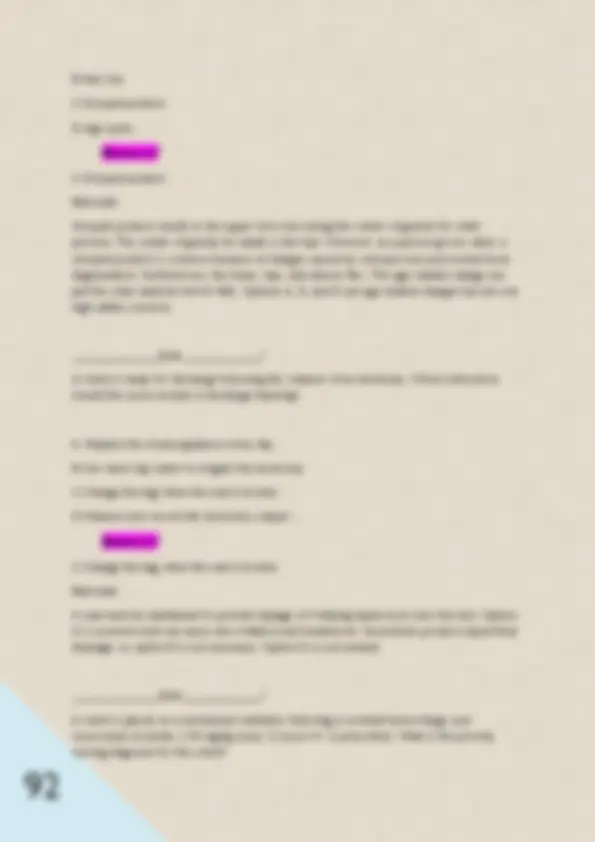
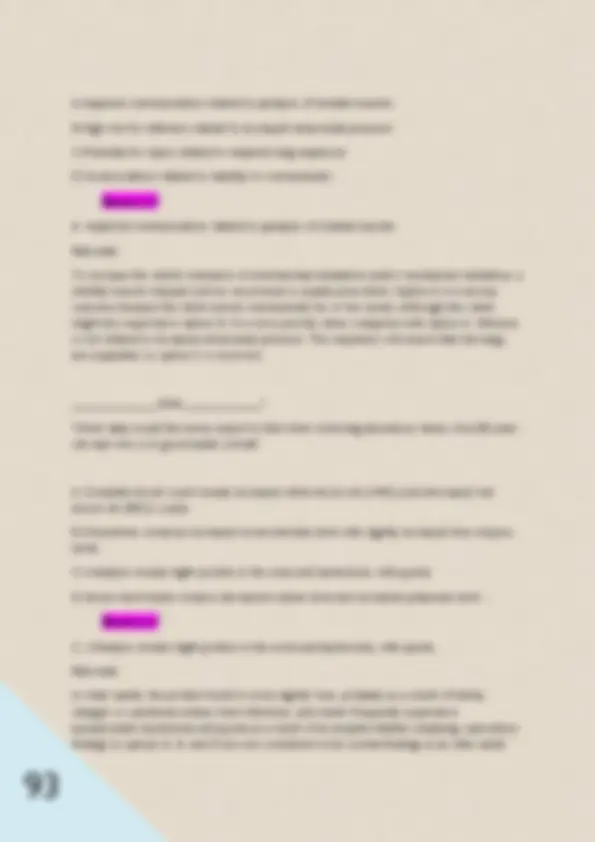
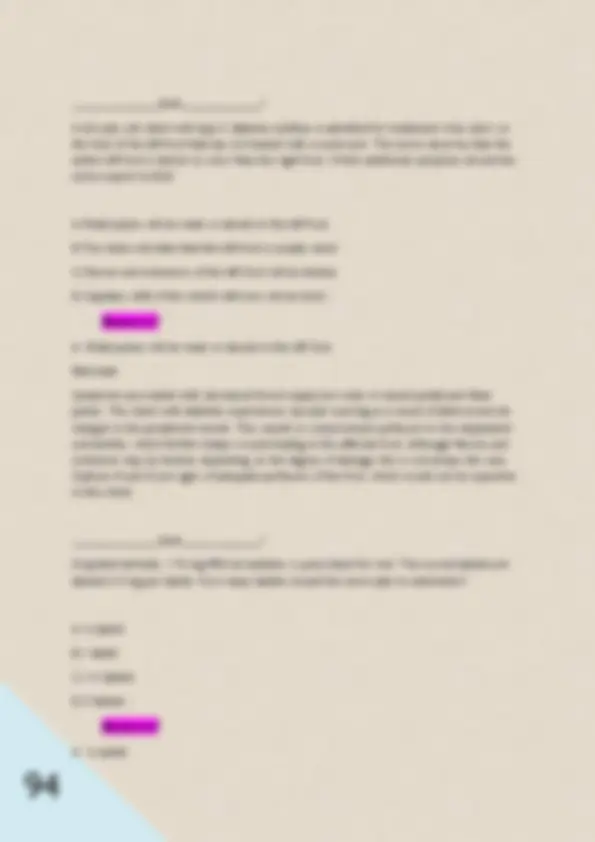
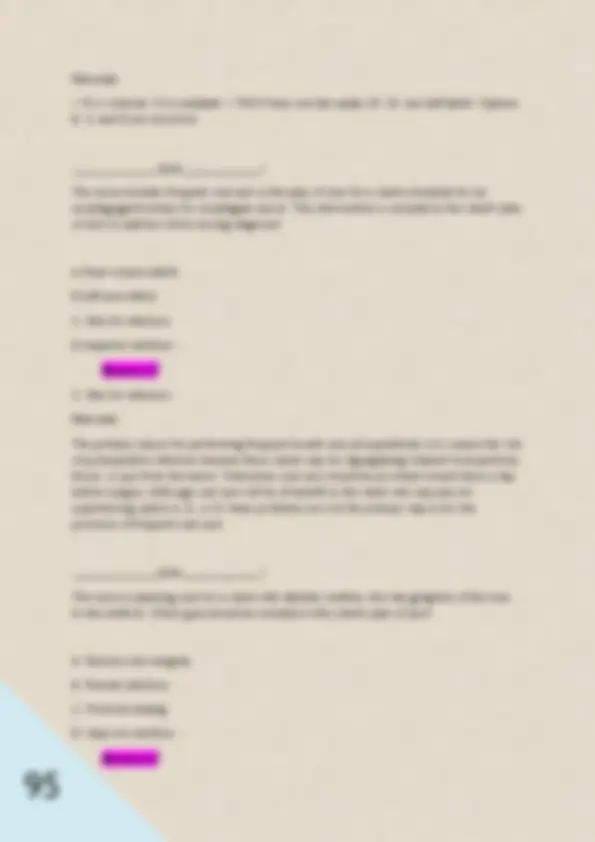
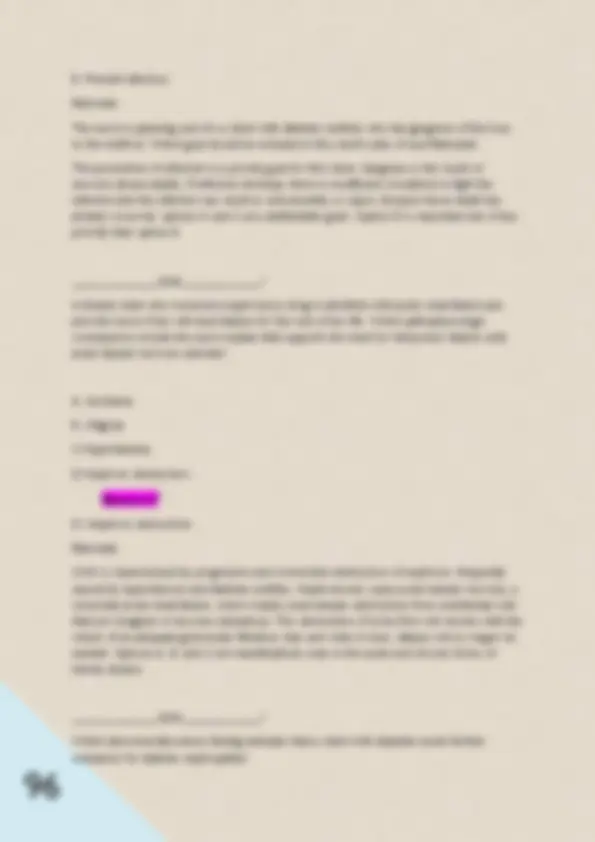
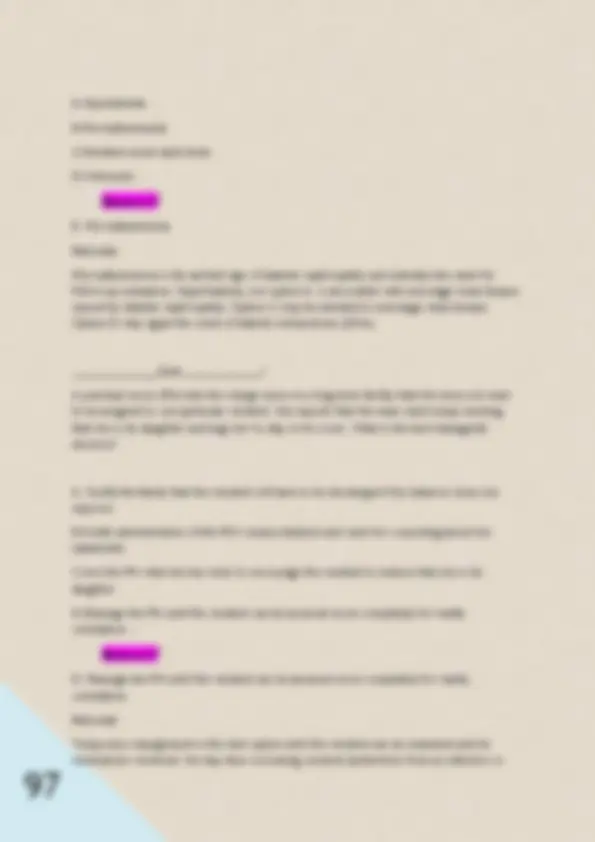
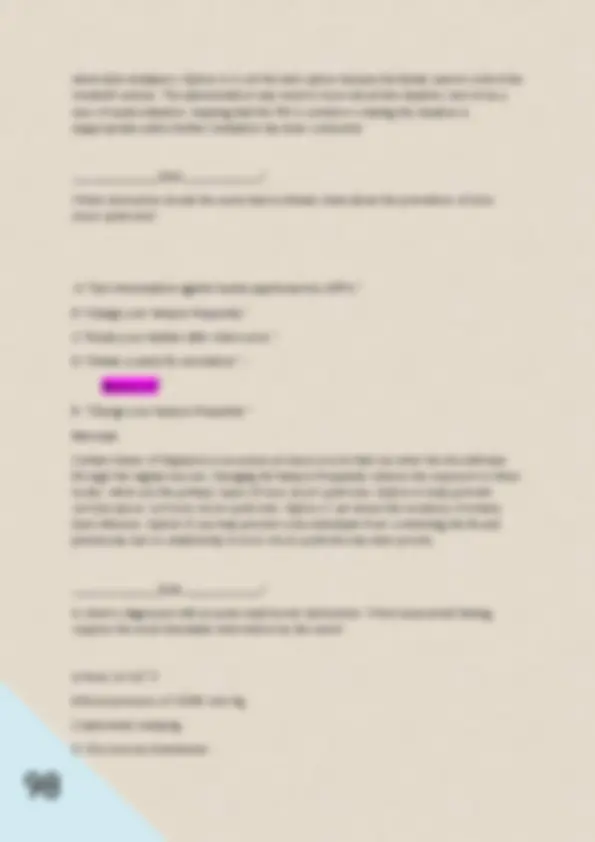
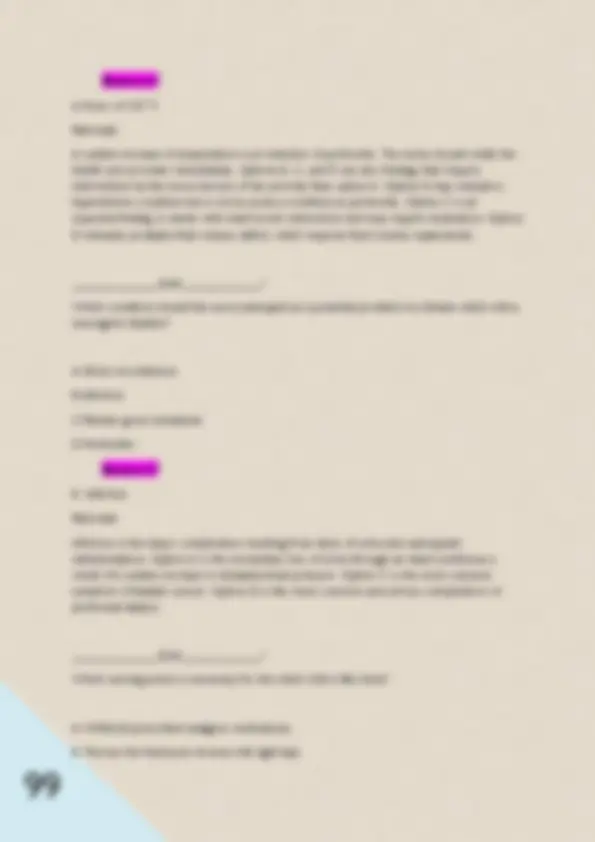
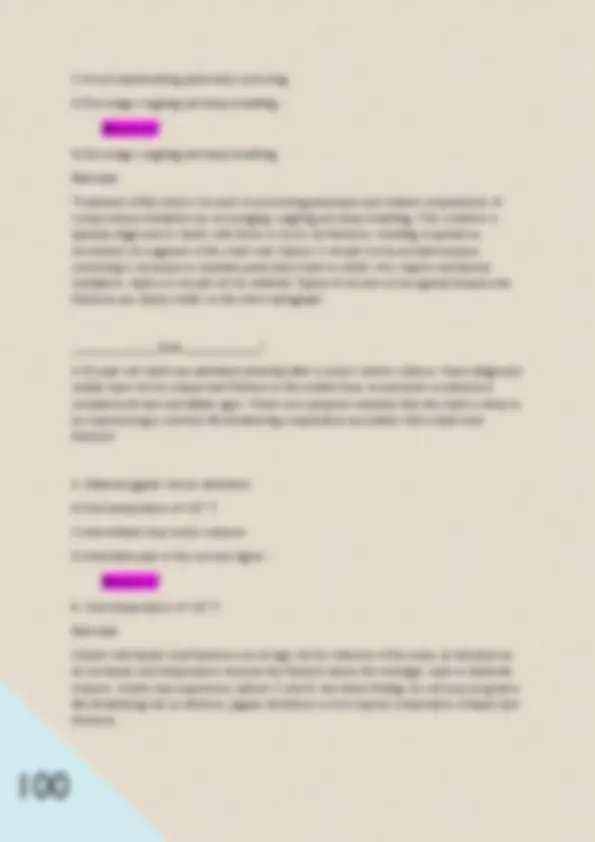


Study with the several resources on Docsity

Earn points by helping other students or get them with a premium plan


Prepare for your exams
Study with the several resources on Docsity

Earn points to download
Earn points by helping other students or get them with a premium plan
Community
Ask the community for help and clear up your study doubts
Discover the best universities in your country according to Docsity users
Free resources
Download our free guides on studying techniques, anxiety management strategies, and thesis advice from Docsity tutors
Med Surg Test bank ( Red HESI Test bank Med-Surg and other resources) Exam Questions with detailed Solutions. _____________Quiz____________? The nurse assesses a patient with shortness of breath for evidence of long-standing hypoxemia by inspecting: A. Chest excursion B. Spinal curvatures C. The respiratory pattern D. The fingernail and its base - Answer✓✓ D. The fingernail and its base Clubbing, a sign of long-standing hypoxemia, is evidenced by an increase in the angle between the base of the nail and the fingernail to 180 degrees or more, usually accompanied by an increase in the depth, bulk, and sponginess of the end of the finger. _____________Quiz____________? 2. The nurse is caring for a patient with COPD and pneumonia who has an order for arterial blood gases to be drawn. Which of the following is the minimum length of time the nurse should plan to hold pressure on the puncture site? A. 2 minutes B. 5 minutes C. 10 minutes D. 15 minutes -
Typology: Exams
1 / 128

This page cannot be seen from the preview
Don't miss anything!





























































































_____________Quiz____________? The nurse assesses a patient with shortness of breath for evidence of long-standing hypoxemia by inspecting: A. Chest excursion B. Spinal curvatures C. The respiratory pattern D. The fingernail and its base -
D. The fingernail and its base Clubbing, a sign of long-standing hypoxemia, is evidenced by an increase in the angle between the base of the nail and the fingernail to 180 degrees or more, usually accompanied by an increase in the depth, bulk, and sponginess of the end of the finger. _____________Quiz____________?
B. 5 minutes Following obtaining an arterial blood gas, the nurse should hold pressure on the puncture site for 5 minutes by the clock to be sure that bleeding has stopped. An artery is an elastic vessel under higher pressure than veins, and significant blood loss or hematoma formation could occur if the time is insufficient. _____________Quiz____________?
A. test the drainage for the presence of glucose. Clear nasal drainage suggests leakage of cerebrospinal fluid (CSF). The drainage should be tested for the presence of glucose, which would indicate the presence of CSF. _____________Quiz____________?
A. Airway patency Remember ABCs with prioritization. Airway patency is always the highest priority and is essential for a patient undergoing surgery surrounding the upper respiratory system. _____________Quiz____________?
D. Basilar crackles -
D. Basilar crackles The presence of adventitious breath sounds indicates that there is accumulation of secretions in the lower airways. This would be consistent with a nursing diagnosis of ineffective airway clearance because the patient is retaining secretions. _____________Quiz____________?
C. Increased vocal fremitus on palpation. A typical physical examination finding for a patient with pneumonia is increased vocal fremitus on palpation. Other signs of pulmonary consolidation include dullness to percussion, bronchial breath sounds, and crackles in the affected area. _____________Quiz____________?
B. Increase fluid intake to 3L/day if tolerated. Although several interventions may help the patient expectorate mucus, the highest priority should be on increasing fluid intake, which will liquefy the secretions so that the patient can expectorate them more easily. Humidifying the oxygen is also helpful, but is not the primary intervention. Teaching the patient to splint the affected area may also be helpful, but does not liquefy the secretions so that they can be removed.
_____________Quiz____________?
C. Pneumococcal The pneumococcal vaccine is important for patients with a history of heart or lung disease, recovering from a severe illness, age 65 or over, or living in a long- term care facility. _____________Quiz____________?
D. "I should continue to do deep-breathing and coughing exercises for at least 6 weeks." It is important for the patient to continue with coughing and deep breathing exercises for 6 to 8 weeks until all of the infection has cleared from the lungs. A patient should seek medical treatment for upper respiratory infections that persist for more than 7 days. Increased fluid intake, not caloric intake, is required to liquefy secretions. Home O2 is not a requirement unless the patient's oxygenation saturation is below normal. _____________Quiz____________?
A. Delay any physical assessment of the patient and review with the family the patient's history of respiratory problems. B. Perform a comprehensive health history with the patient to review prior respiratory problems. C. Perform a physical assessment of the respiratory system and ask specific questions related to this episode of respiratory distress. D. Complete a full physical examination to determine the effect of the respiratory distress on other body functions. -
C. Perform a physical assessment of the respiratory system and ask specific questions related to this episode of respiratory distress.Because the patient is having respiratory difficulty, the nurse should ask specific questions about this episode and perform a physical assessment of this system. Further history taking and physical examination of other body systems can proceed once the patient's acute respiratory distress is being managed. _____________Quiz____________?
D. Mucociliary clearance Smoking decreases the ciliary action in the tracheobronchial tree, resulting in impaired clearance of respiratory secretions, chronic cough, and frequent respiratory infections. _____________Quiz____________?
B. Move the oximetry probe from the finger to the earlobe for more accurate monitoring during activity. C. Obtain a physician's order for supplemental oxygen to be used during ambulation and other activity. D. Obtain a physician's order for arterial blood gas determinations to verify the oxygen saturation. -
C. Obtain a physician's order for supplemental oxygen to be used during ambulation and other activity. An oxygen saturation level that drops below 90% with activity indicates that the patient is not tolerating the exercise and needs to have supplemental oxygen applied. _____________Quiz____________?
B. Pulmonary embolus from deep vein thrombosis The patient presents the classic symptoms of pulmonary embolus: acute onset of symptoms, tachypnea, shortness of breath, and chest pain. _____________Quiz____________?
A. Anxiety An early symptom during an asthma attack is anxiety because he is acutely aware of the inability to get sufficient air to breathe. He will be hypoxic early on with decreased PaCO2 and increased pH as he is hyperventilating. _____________Quiz____________?
D. Evaluate the use of intercostal muscles The nurse physically inspects the chest wall to evaluate the use of intercostal (accessory) muscles, which gives an indication of the degree of respiratory distress experienced by the patient. _____________Quiz____________?
D. Reverse Trendelenburg -
C. High-Fowler'sThe patient experiencing an asthma attack should be placed in high- Fowler's position to allow for optimal chest expansion and enlist the aid of gravity during inspiration. _____________Quiz____________?
A. Wheezing becomes louder The primary problem during an exacerbation of asthma is narrowing of the airway and subsequent diminished air exchange. As the airways begin to dilate, wheezing gets louder because of better air exchange. _____________Quiz____________?
D. Work of breathingWhen the patient does not have sufficient gas exchange to engage in activity, the etiologic factor is often the work of breathing. When patients with asthma do not have effective respirations, they use all available energy to breathe and have little left over for purposeful activity.
B. Empty the lungs and then inhale quickly through the mouthpiece to measure how fast air can be inhaled. C. Keep a record of the peak flow meter numbers if symptoms of asthma are getting worse. D. Increase the doses of the long-term control medication if the peak flow numbers decrease. -
C. Keep a record of the peak flow meter numbers if symptoms of asthma are getting worse. It is important to keep track of peak flow readings daily and when the patient's symptoms are getting worse. The patient should have specific directions as to when to call the physician based on personal peak flow numbers. Peak flow is measured by exhaling into the meters and should be assessed before and after medications to evaluate their effectiveness. _____________Quiz____________?
A. "Close lips tightly around the mouthpiece and breathe in deeply and quickly." Dry powder inhalers do not require spacer devices. The patient should be instructed to breathe in deeply and quickly to ensure medicine moves down deeply into lungs. The patient may not taste or sense the medicine going into the lungs. _____________Quiz____________?
D. Hypertension and pulmonary edema -
C. Oropharyngeal candidiasis and hoarseness Oropharyngeal candidiasis and hoarseness are common adverse effects from the use of inhaled corticosteroids because the medication can lead to overgrowth of organisms and local irritation if the patient does not rinse the mouth following each dose. _____________Quiz____________?
D. "More of the medication will get down into my lungs to help my breathing." A spacer assists more medication to reach the lungs, with less being deposited in the mouth and the back of the throat. _____________Quiz____________?
A. A decreased exhaled nitric oxide. Nitric oxide levels are increased in the breath of people with asthma. A decrease in the exhaled nitric oxide concentration suggests that the treatment may be decreasing the lung inflammation associated with asthma.
A. Intake and output Corticosteroids such as prednisone can lead to fluid retention. For this reason, it is important to monitor the patient's intake and output. _____________Quiz____________?
D. Rinse the mouth with water following the second puff of medication. The patient should rinse the mouth with water following the second puff of medication to reduce the risk of fungal overgrowth and oral infection. _____________Quiz____________?
B. Serevent The trade or brand name for salmeterol, an adrenergic bronchodilator, is Serevent. _____________Quiz____________?
important information to prevent medication underdosing when the patient describes which method to check the inhaler? A. Place it in water to see if it floats. B. Shake the canister while holding it next to the ear. C. Check the indicator line on the side of the canister. D. Keep track of the number of inhalations used. -
D. Keep track of the number of inhalations used. It is no longer appropriate to see if a canister floats in water or not as research has demonstrated this is not accurate. The best method to determine when to replace an inhaler is by knowing the maximum puffs available per MDI and then replacing when those inhalations have been used. _____________Quiz____________?
D. Atrovent The trade or brand name for ipratropium bromide, an anticholinergic medication, is Atrovent. _____________Quiz____________?
C. Effective and productive coughing D. PaO2 within normal range for the patient -
C. Effective and productive coughing The issue of the question is airway clearance, which is most directly evaluated as successful if the patient can engage in effective and productive coughing. _____________Quiz____________?
D. Order a high-calorie, high-protein diet with six small meals a day.Because the patient with COPD needs to use greater energy to breathe, there is often decreased oral intake because of dyspnea. A full stomach also impairs the ability of the diaphragm to descend during inspiration, interfering with the work of breathing. Finally, the metabolism of a high carbohydrate diet yields large amounts of CO2, which may lead to acidosis in patients with pulmonary disease. For these reasons, the patient with emphysema should take in a high- calorie, high-protein diet, eating six small meals per day. _____________Quiz____________?
A. Preventing bronchial collapse and air trapping in the lungs during exhalation The focus of pursed lip breathing is to slow down the exhalation phase of respiration, which decreases bronchial collapse and subsequent air trapping in the lungs during exhalation. _____________Quiz____________?
C. Fluid volume excess secondary to cor pulmonale Cor pulmonale is a right-sided heart failure caused by resistance to right ventricular outflow due to lung disease. With failure of the right ventricle, the blood emptying into the right atrium and ventricle would be slowed, leading to jugular venous distention and pedal edema. _____________Quiz____________?
B. "Oxygen will be needed when your oxygen saturation drops to 88% and you have symptoms of hypoxia.Long-term oxygen therapy in the home should be considered when the oxygen saturation is 88% or less and the patient has signs of tissue hypoxia, such as cor pulmonale, erythrocytosis, or impaired mental status.